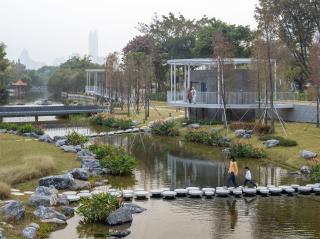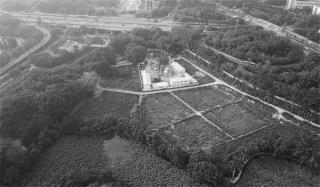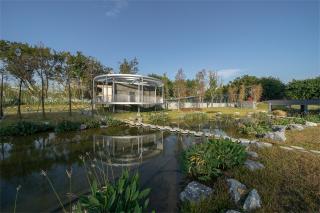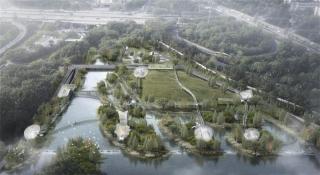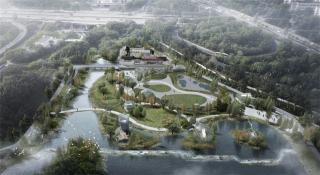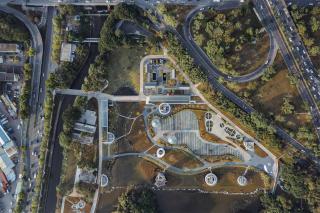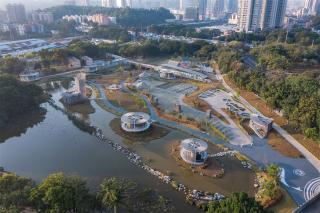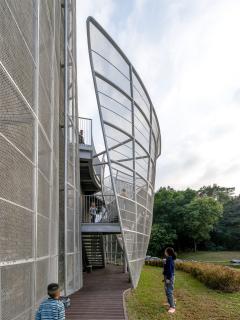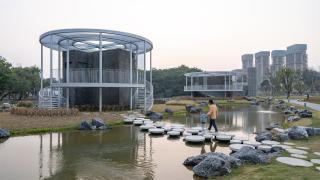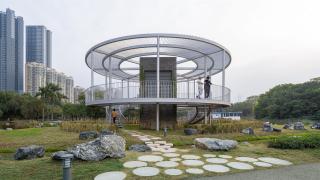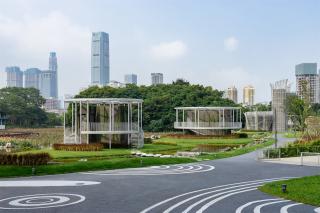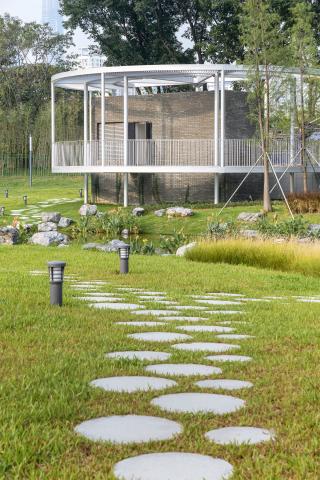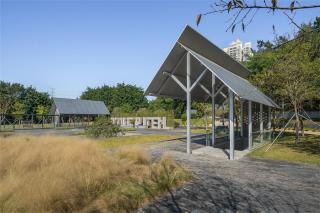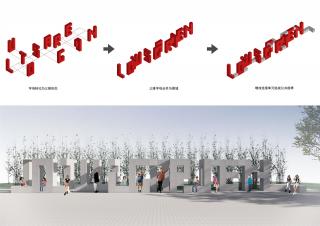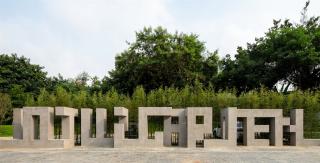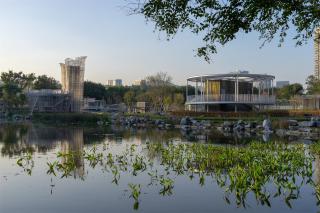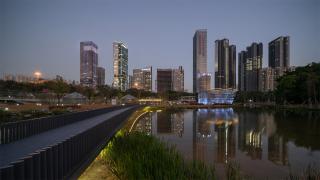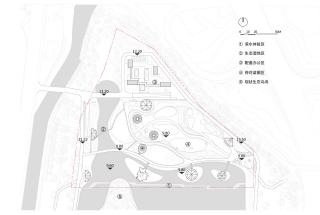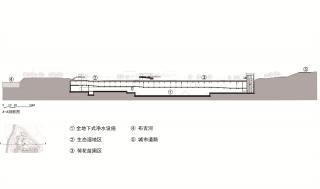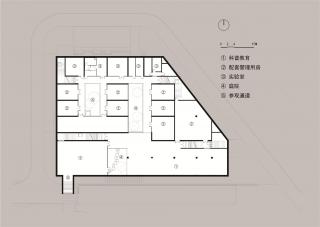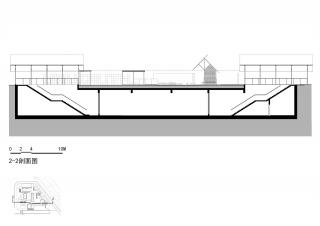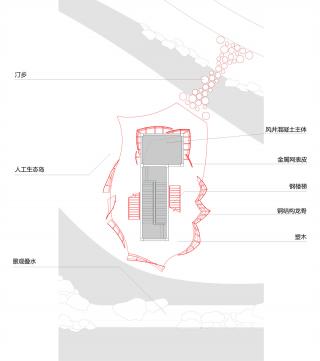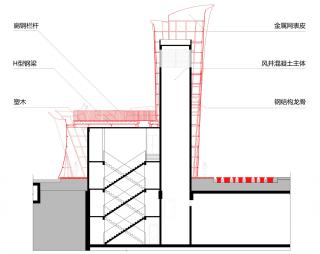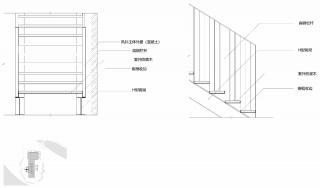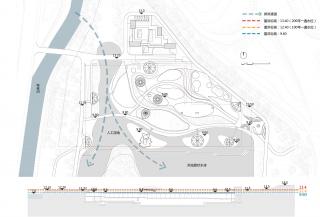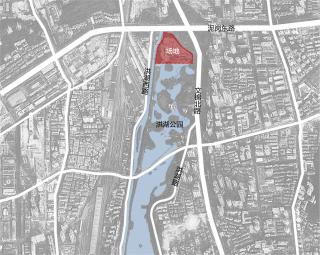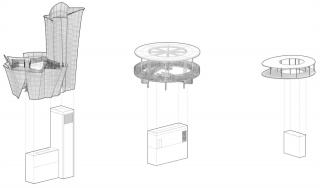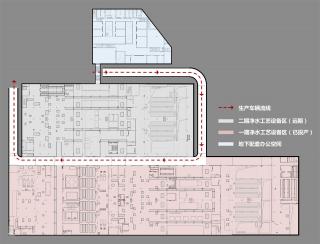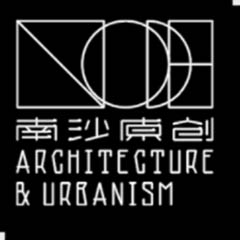全地下水質(zhì)凈化廠,地上城市公園
An Urban Park on Top of a Fully-buried Water Treatment Plant
▼基礎(chǔ)設(shè)施公共化:深圳荷水文化基地 ?張超
Infrastructure Publicization: Shenzhen Lotus Water Culture Base ?Zhang chao

01 背景與歷程
01 Background and History
項(xiàng)目位于深圳市羅湖區(qū)洪湖公園北端�,泥崗東路南側(cè),布吉河?xùn)|側(cè)����。洪湖公園是一個(gè)以荷花為主題的市級(jí)公園,坐擁落羽杉林和白鷺群���。公園于1985年建成開放�,既是深圳特區(qū)成立后最早建設(shè)的一批公園�����,也是深圳市民心目中最重要的城市公園之一���。
The Project is located at the northern end of Honghu Park, Luohu District, Shenzhen City, south of Nigang East Road and east of Buji River. Honghu Park is a lotus-themed municipal park known for its bald cypress forest and white egret flock. Completed and opened in 1985, it is not only one of the earliest parks built after the establishment of Shenzhen Special Economic Zone, but also one of the most important urban parks in the eyes of Shenzhen citizens.
▼場(chǎng)地與城市周邊空間關(guān)系 ?NODE
Relationship between site and surrounding space ?NODE
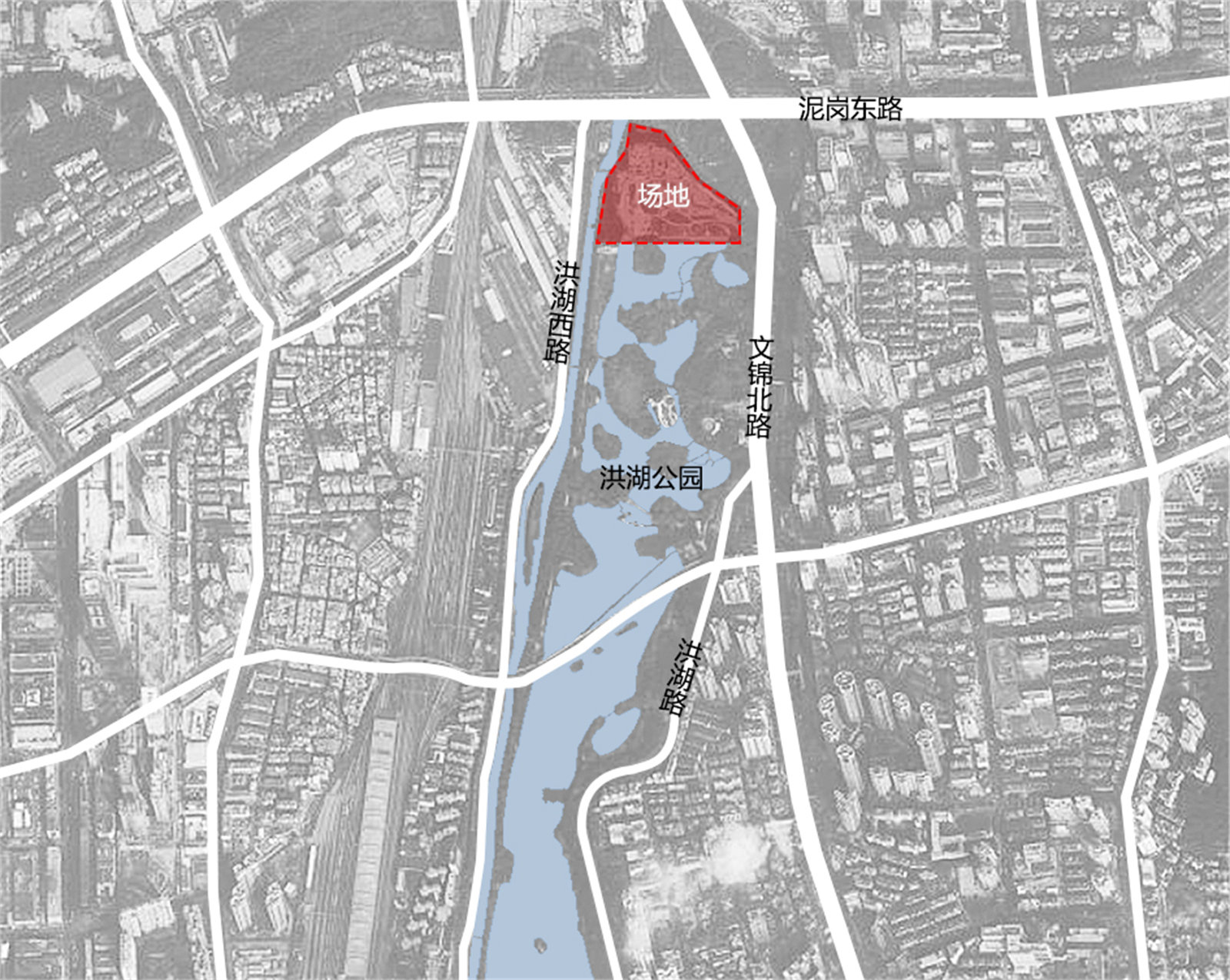
為了解決城市突出的水環(huán)境問題�,《深圳市治水提質(zhì)工作計(jì)劃(2015-2020年)》于2015年發(fā)布����,擬投入816億元治水���,新/擴(kuò)建19座污水處理廠,改造24座污水處理廠����,加快河流綜合整治;其中新建的洪湖公園水質(zhì)凈化廠是此次深圳市水污染治理工作的重點(diǎn)工程��,建成后每年可為周邊區(qū)域凈化生活污水約1800萬(wàn)立方米(約等于杭州西湖水量的1.3倍)�,將有效緩解清水河—筍崗片區(qū)城市更新發(fā)展帶來(lái)的污水增量問題。洪湖公園水質(zhì)凈化廠采用的是全埋地式先進(jìn)凈水技術(shù)��,對(duì)應(yīng)需恢復(fù)的地面景觀約3.24公頃��。
To tackle the much-concerned water environment problems, the city released Shenzhen Water Control and Quality Improvement Work Plan (2015-2020) was released in 2015, which proposed an investment of CNY 81.6 billion on improvement of water environment, including construction and expansion of 19 sewage treatment plants, improvement of 24 ones, and accelerated river improvement initiatives. The newly built Honghu Park Water Purification Plant, one of the key projects for water pollution control under the Work Plan, employs a leading fully-buried water purification technology and involves the restoration of surface landscape of about 3.24 ha. It aims to effectively alleviate the sewage increase problems resulting from the urban renewal and development in Qingshui River - Sungang Area. Upon completion, the facility can treat and purify about 18 million m3 of domestic sewage for the surrounding areas every year, an equivalent of about 1.3 times the water volume of the West Lake in Hangzhou.
▼洪湖公園北側(cè)地塊原狀航拍(施工前) ?西南市政院
Aerial in the north of Honghu Park (before construction)?Southwest Municipal Council
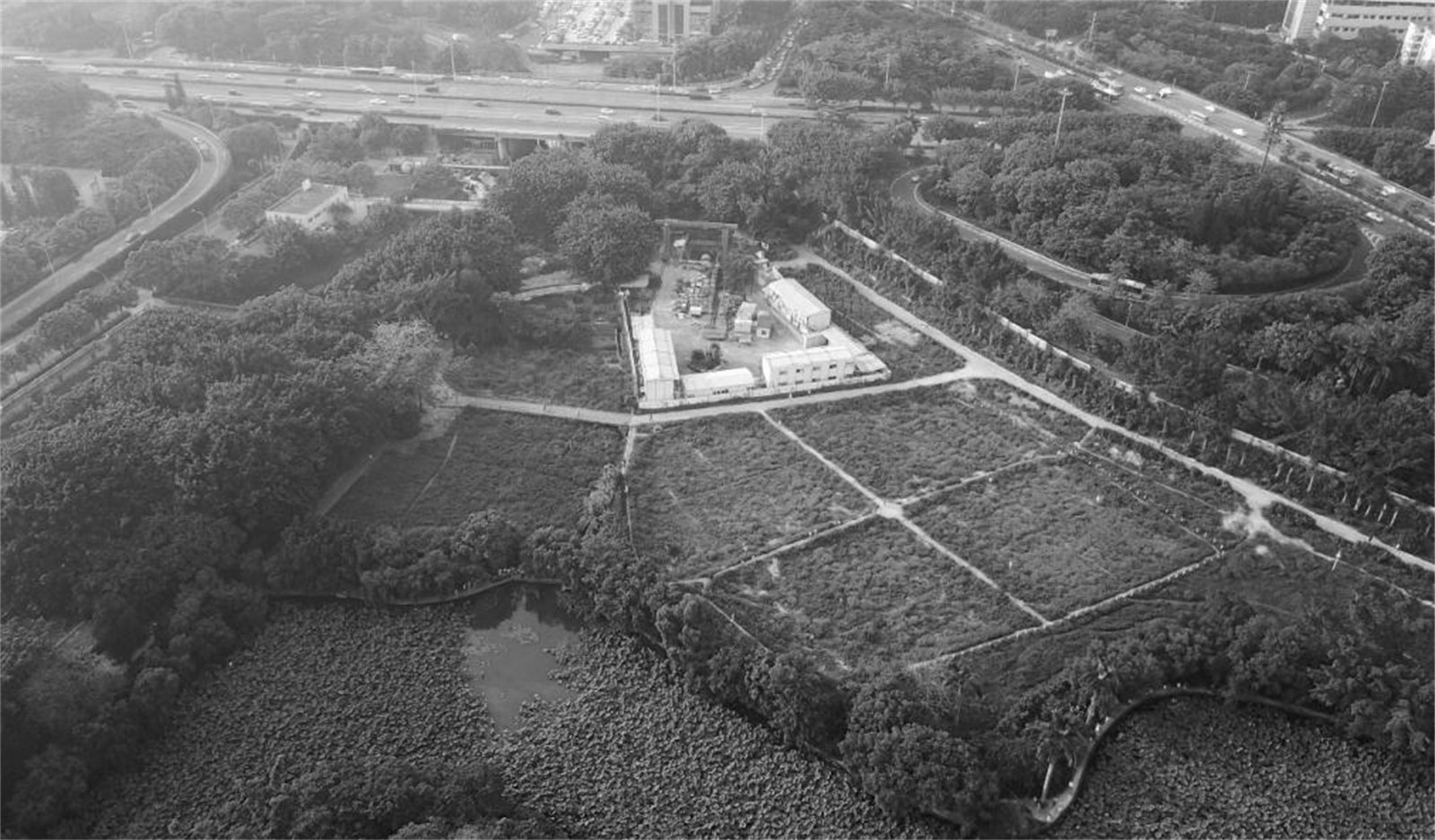
當(dāng)我們介入項(xiàng)目之時(shí)�����,全地下水質(zhì)凈化廠已由市政工程設(shè)計(jì)單位完成設(shè)計(jì)及施工圖并準(zhǔn)備施工��,我們承擔(dān)的部分是凈水廠上蓋地面景觀恢復(fù)設(shè)計(jì)�,以及北端地下配套辦公建筑設(shè)計(jì)。
When we joined the project team, the general contracting designer had completed the design and construction drawings of the underground water purification plant and everything had been ready for construction. In this project, we were asked to design the restored surface landscape on top of the water purification facility, and the underground offices at the northern end.
02 設(shè)計(jì)挑戰(zhàn)
02 Design Challenges
雖然我們?cè)谠擁?xiàng)目只負(fù)責(zé)地面景觀提升,但因其與地下凈水廠以及地表防洪工程要求息息相關(guān)����,作為方案設(shè)計(jì)師,我們需要對(duì)景觀設(shè)計(jì)背后的技術(shù)邏輯及生產(chǎn)流程及其邏輯有一定深度的理解和研究����,并在此基礎(chǔ)上超越工程邏輯,嘗試創(chuàng)造一個(gè)符合空間美學(xué)����、社區(qū)友好的公共空間場(chǎng)所�����。
Though we were engaged to only provide SD for the surface landscape improvement in the Project, we had to achieve sufficient understanding and conduct necessary research about the technical logic and production process/logic behind the landscape design, as the surface landscape is closely related to the underground facility and the surface flood control requirements. On this basis, we intended to go beyond the engineering logic, and tried to create an aesthetic and community-friendly public space.
水安全
Water Safety
每年澇季��,場(chǎng)地西側(cè)布吉河水位上漲���,到達(dá)一定高度后���,水流會(huì)從布吉河進(jìn)入洪湖形成蓄洪區(qū),緩解澇季水位上漲壓力�。設(shè)計(jì)場(chǎng)地為低洼地,位于行洪通道上,項(xiàng)目最終防洪安全評(píng)估標(biāo)高���,明確百年一遇的防洪標(biāo)為12.4m�,200年一遇的為13.4m�����。目前場(chǎng)地一方面需要景觀提升�����,同時(shí)作為行洪的緩沖區(qū)����,也要滿足行洪通道的要求。謹(jǐn)慎處理現(xiàn)狀場(chǎng)地標(biāo)高和設(shè)計(jì)標(biāo)高是保證水安全的基本要求���。例如��,出地面的風(fēng)井門窗洞口�,最低標(biāo)高須達(dá)到百年一遇標(biāo)高12.4m��;而疏散樓梯出口和配套辦公建筑而須達(dá)到200年一遇的13.4m��。
In the flood season every year, the water level of Buji River west of the site rises. When the water level reaches a certain height, the river water will flow into Honghu Lake where a flood storage area is formed to alleviate the water level rise in the flood season. As the site is a low land that falls within the flood discharge passage, the final flood control safety assessment of the Project determined that the site elevation for 100-year flood is 12.4 m and that for a 200-year flood is 13.4 m. In this case, the site landscape needed improvement while meeting the requirement on flood discharge passage as a buffer for flood discharge. To ensure water safety, it was fundamental to tackle the existing site elevation and designed ones with due care. For example, the lowest elevation of the vent shaft door and window opening out of the ground must reach 100-year flood is 12.4 m; The evacuation staircase exits and supporting office buildings must reach 200-year flood is 13.4 m.
▼風(fēng)井與濱水汀步 ?張超
Vent shaft and waterfront ting step ?Zhang Chao
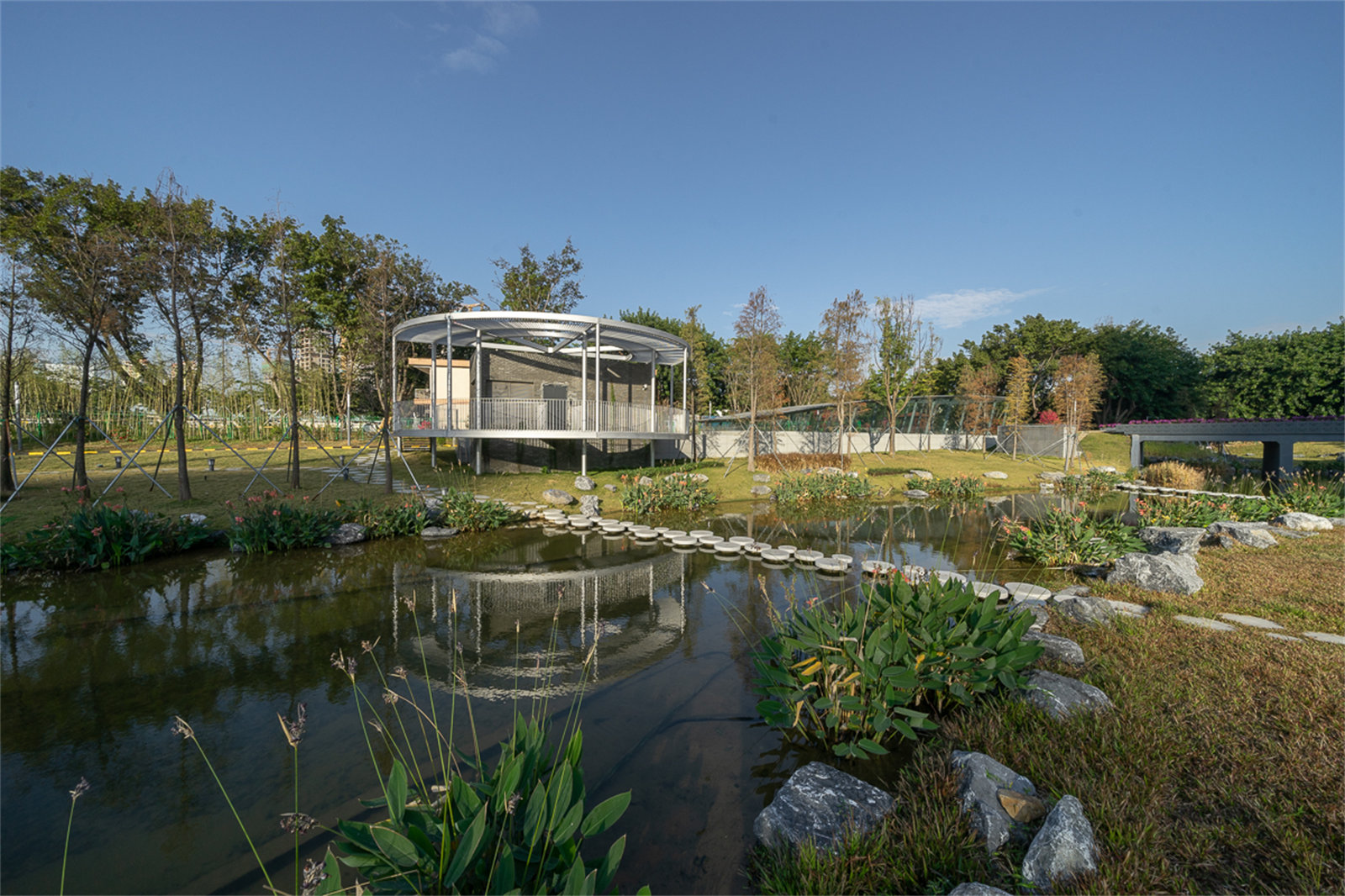
水處理
Water Treatment
洪湖水質(zhì)凈化廠占地面積為1.67公頃,共分兩期建設(shè)����。水處理的技術(shù)部分采用全地下式雙層框架結(jié)構(gòu),一期工程水處理規(guī)模為每天5萬(wàn)立方米���,遠(yuǎn)期每天10萬(wàn)立方米��。凈化后出水作為洪湖公園和布吉河的生態(tài)景觀補(bǔ)水����,可達(dá)地表水環(huán)境質(zhì)量準(zhǔn)Ⅳ類標(biāo)準(zhǔn)的要求���。該部分設(shè)計(jì)在我們介入之前,已由市政工程設(shè)計(jì)單位全部完成����。全地下建筑不可避免地帶來(lái)了許多地上建筑無(wú)需特殊處理的事宜,例如風(fēng)井及消防疏散等在地面上顯性的形式問題�����。原本埋地“去工業(yè)化”的初衷��,在現(xiàn)實(shí)中又以另一種形式呈現(xiàn)和被帶入。這也是這個(gè)項(xiàng)目的特殊之處��,也是地面景觀恢復(fù)設(shè)計(jì)最重要的挑戰(zhàn)之一�����。
Honghu Lake Water Treatment Plant on a 1.67 ha site was to be built in two phases. The technical part for water treatment is a fully-buried double-layer frame structure, with the water treatment capacity of 50,000 m3 and 100,000 m3 per day in Phase I and long term respectively. The main indices shall meet the requirements of quasi class IV water body in the Standard for Environmental Quality of Surface Water. The treated effluent is used to supplement the water in the ecological landscape of Honghu Park and Buji River. The design for this part had been fully completed by the general contracting designer before we were brought aboard. In fact, the fully-buried building inevitably brought issues that need no special attention in the case of surface buildings, such as the forms of the visible above-grade part of the underground ventilation and fire control facilities, which were the focus of design. The original intention of buried facilities for "deindustrialization" was actually presented and brought into reality in another form. This was also the unique feature of the Project and one of the most important challenges facing the surface landscape restoration design.
▼地下凈水(-1F)工藝流程示意圖 ?NODE
Diagram of underground water purification (-1F) process ?NODE
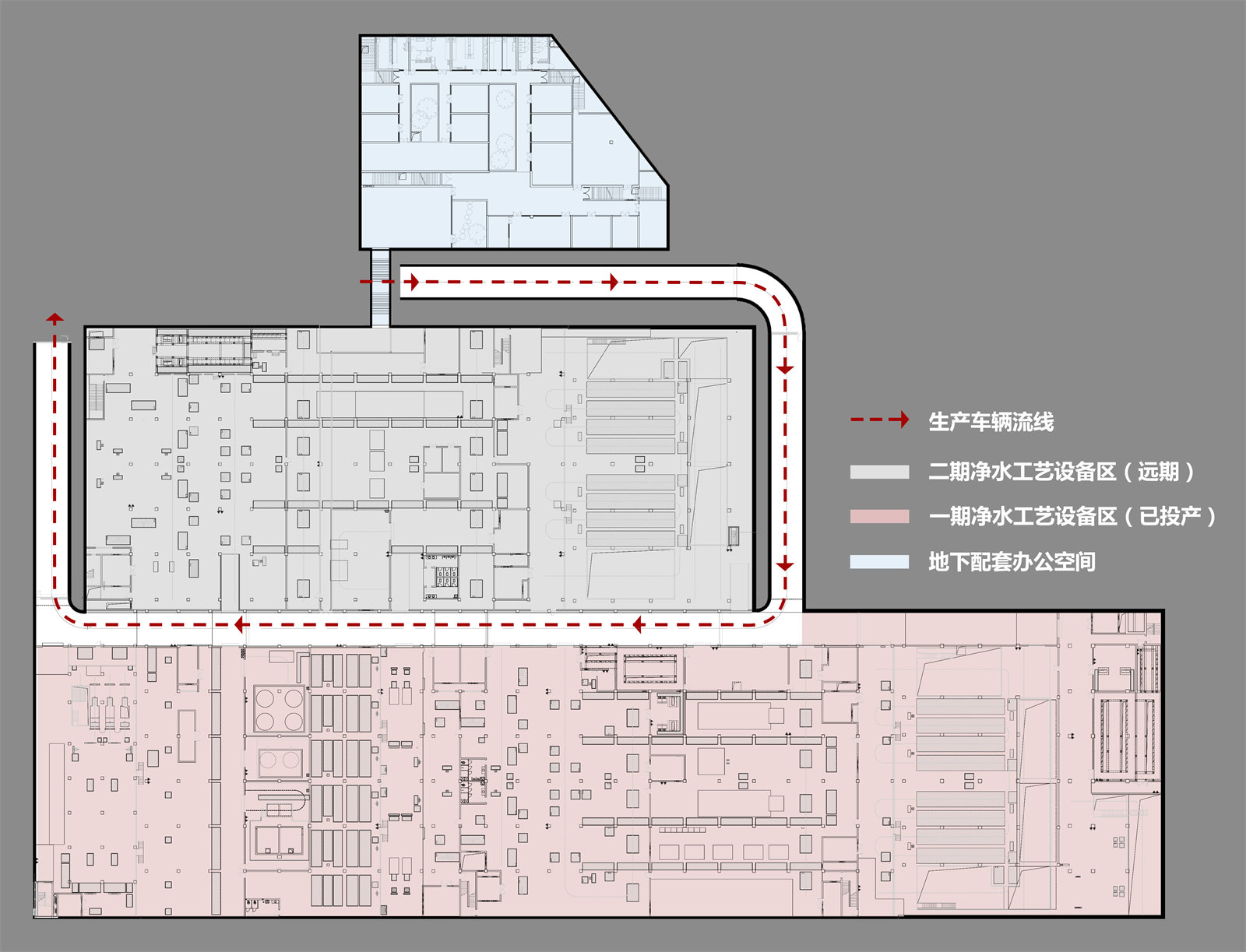
▼地下凈水(-2F)工藝流程示意圖 ?NODE
Diagram of underground water purification (-2F) process ?NODE
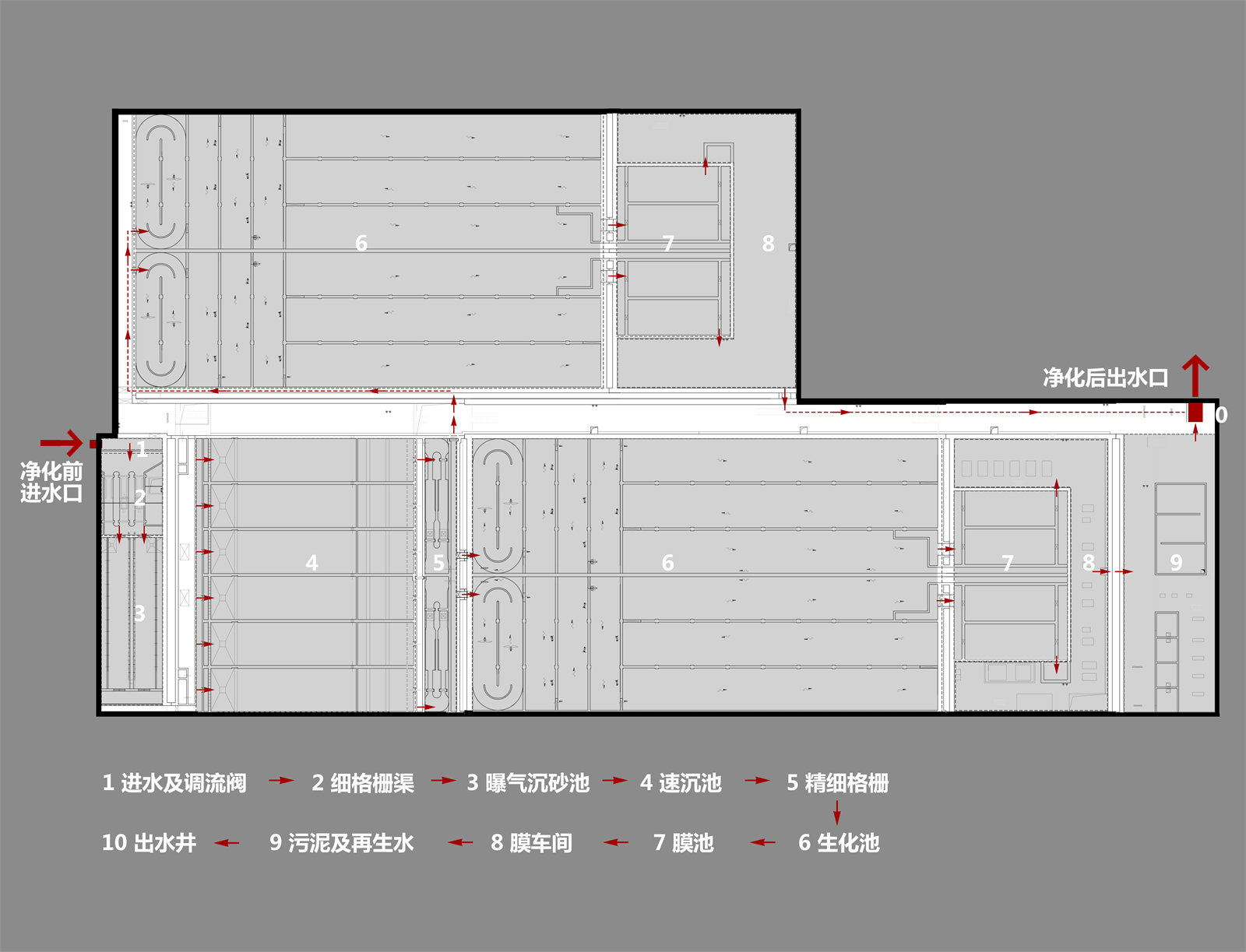
▼地下凈水廠(-1F)空間 ?張超
Underground Water Purification Plant (-1F) Space ? Zhang Chao
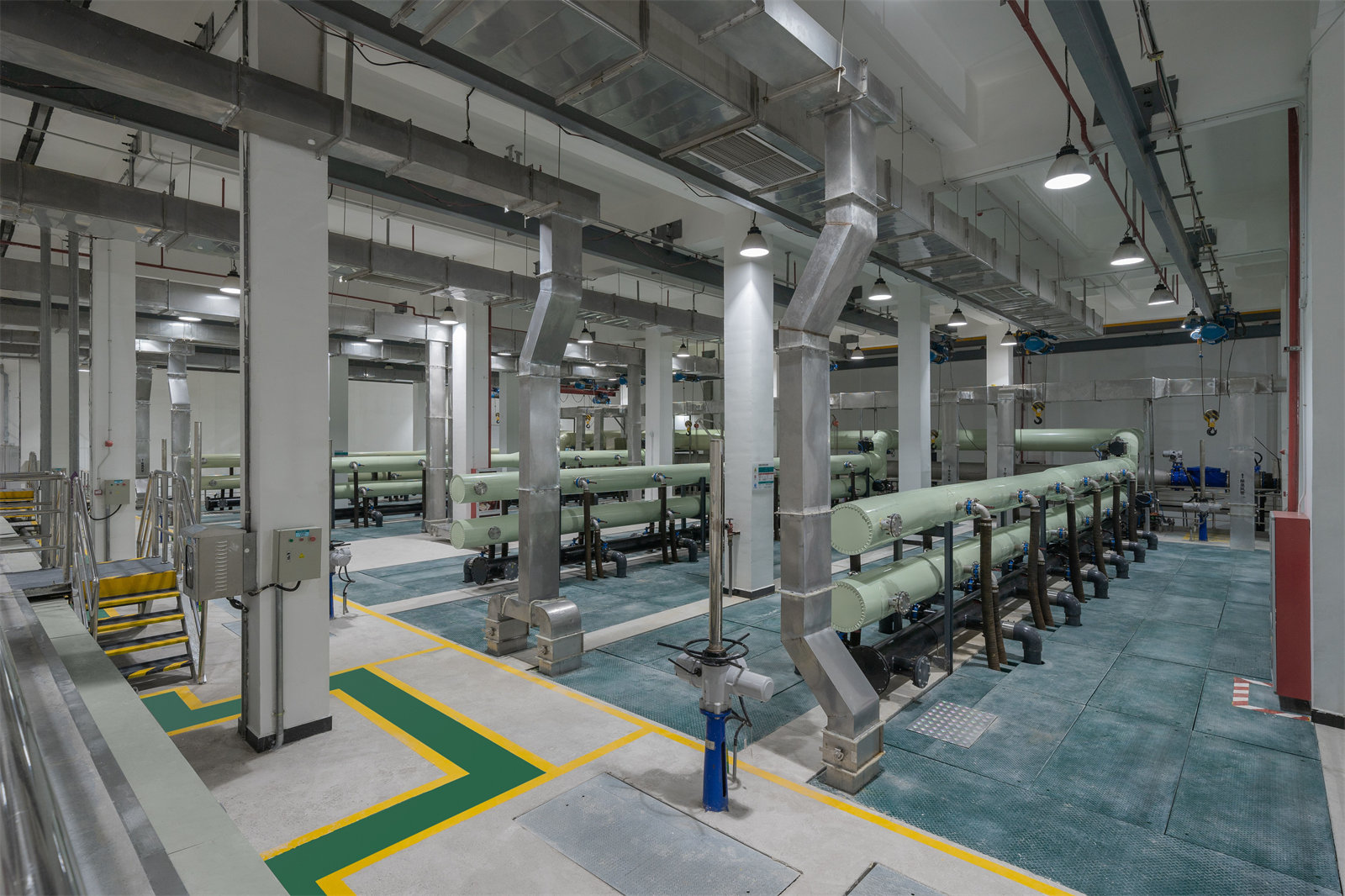
多方訴求
Claims of Different Stakeholder
除了上述與水工程有關(guān)的設(shè)計(jì)挑戰(zhàn)�����,由于洪湖公園在城市的重要地位和關(guān)注度����,此項(xiàng)目的設(shè)計(jì)從一開始,多方(政府����、公園方、運(yùn)營(yíng)方等)不同的訴求在我們介入后的各個(gè)階段接踵而來(lái)���。如政府方要求地面恢復(fù)綠化率達(dá)86%��,符合濕地規(guī)劃���,處理好原生態(tài)鳥島與景觀的關(guān)系���,并要結(jié)合海綿城市進(jìn)行設(shè)計(jì);公園方要求地面景觀須讓出近7000㎡作為荷花苗圃培育基地�,恢復(fù)自然的湖岸線及水體近5000㎡;運(yùn)營(yíng)方則要求打造“去工業(yè)化“的野趣景觀���,結(jié)合公共科普參觀����,轉(zhuǎn)化公眾對(duì)“污水廠”的刻板印象等等��。在我們看來(lái)�����,這是當(dāng)下城市眾多項(xiàng)目在設(shè)計(jì)過程中遭遇的典型問題�,設(shè)計(jì)永遠(yuǎn)“在路上”,需要始終保持“變”的心態(tài)去應(yīng)對(duì)不同階段的各類述求���,力保“在路上”的設(shè)計(jì)不影響施工的整體進(jìn)度�;但對(duì)我們而言,最大的挑戰(zhàn)是在不斷“變”的過程中要保證我們方案的初衷和設(shè)計(jì)最終的整體性���。
In addition to the above water-related design challenges, we were also faced with various claims from different stakeholders (such as the government, the park authority, and Operator)as we started our designs, due to the park’s importance and much attention it had attracted. For example, the government required that the greening rate of the ground should be restored to 86%, the wetland planning be followed and the relationship between the original ecological bird island(s) and the landscape be well balanced under the sponge city concept. The park management needed nearly 7,000 m2 as a lotus nursery cultivation base, and the restoration of the natural lake shoreline and nearly 5,000 m2 of water body. The operators aspired for creating a “deindustrialized” wild landscape which, coupled with public science visits, may change people’s stereotype about “sewage plant”. In our opinion, these are typical issues encountered in the design process of many urban projects. Design is always "on the way", and we should always keep a "change-embracing" mindset towards various requirements in different stages, to ensure that the "on-the-way" design will not affect the overall progress of construction; but for us, the biggest challenge was to ensure the original intention and the final completeness of the design in a continuous "changing" process.
▼過程版野趣的Detour方案效果圖 ?NODE
Process version of Detour scheme effect ?NODE
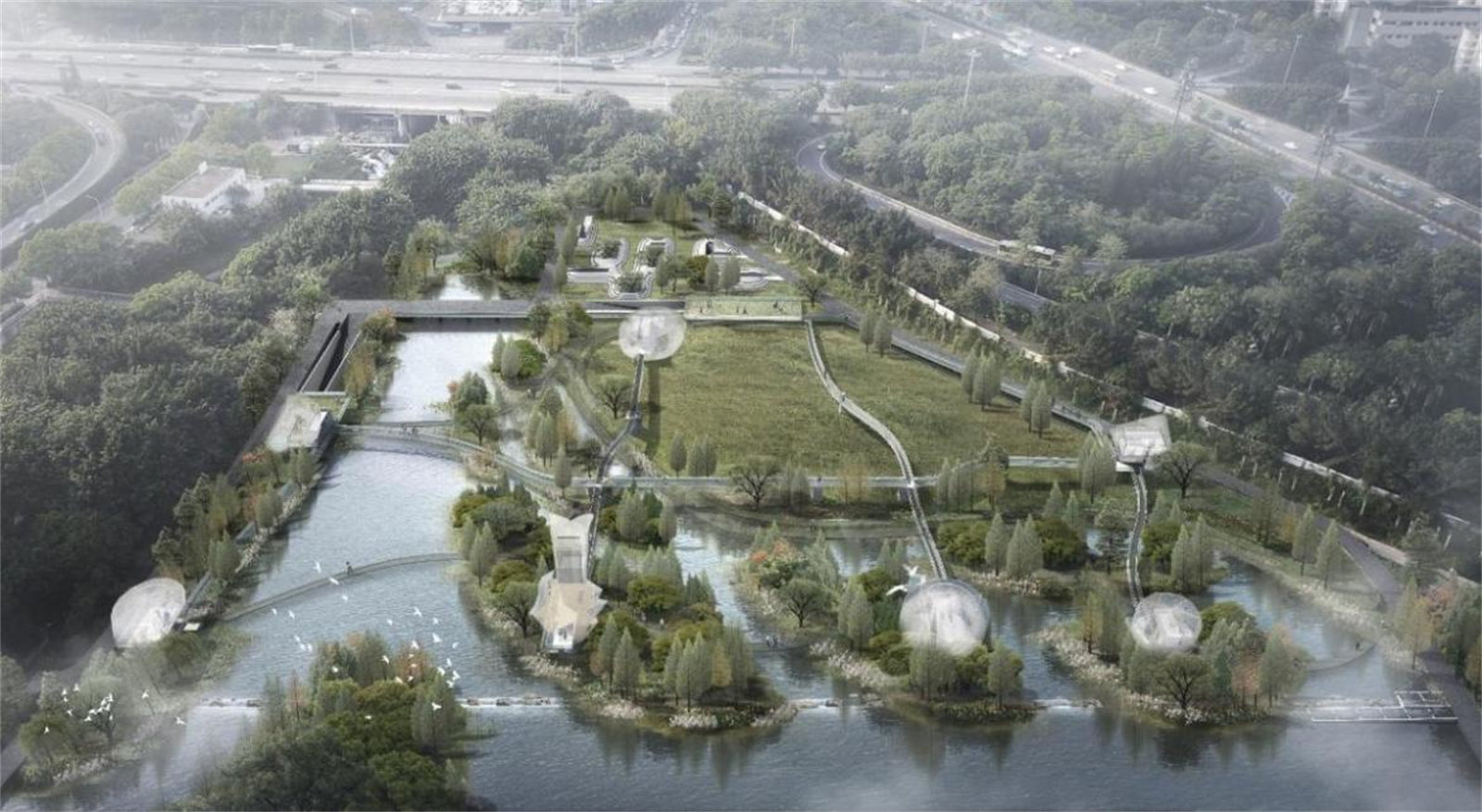
▼最終實(shí)施版方案效果圖 ?NODE
Final implementation scheme effect picture ?NODE
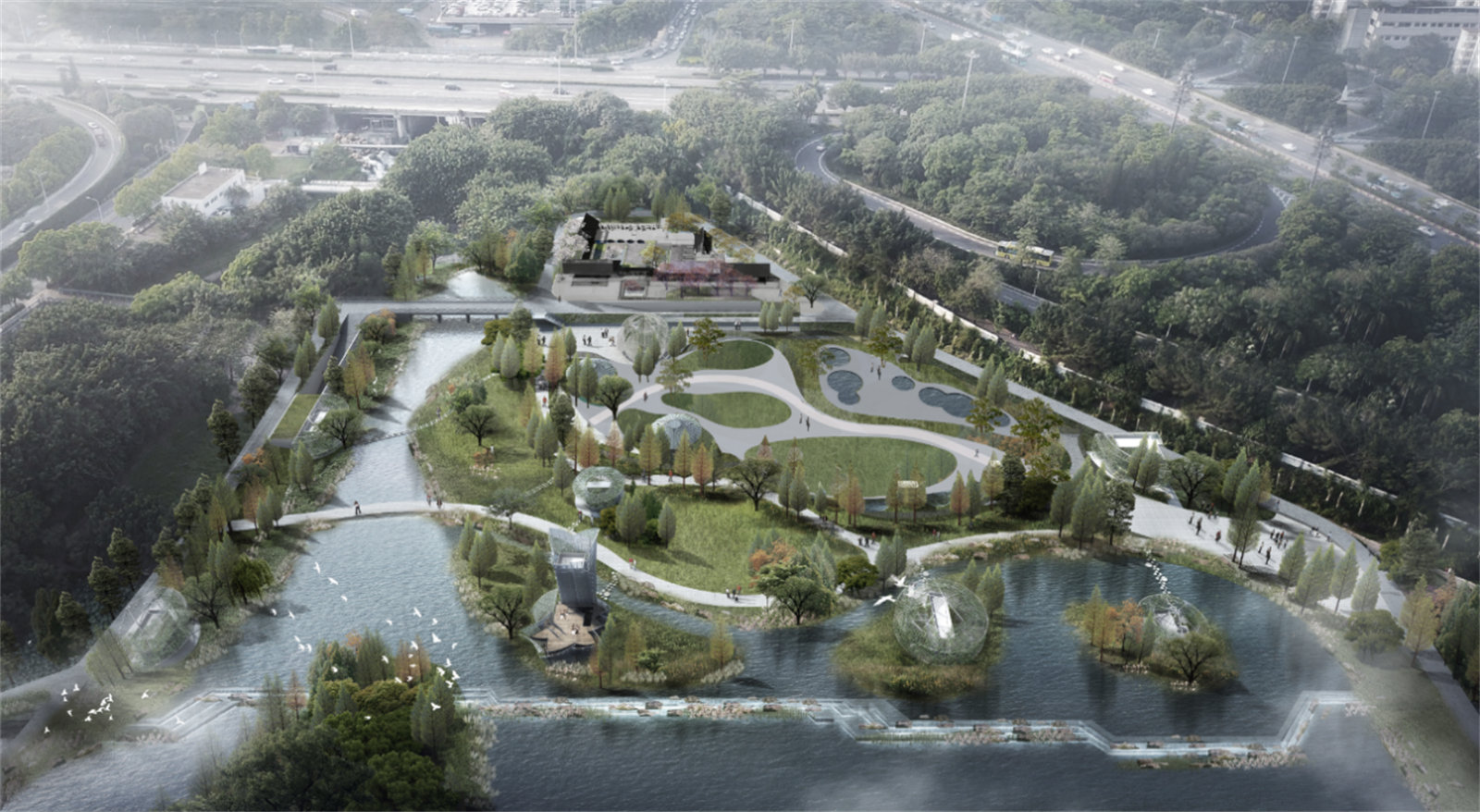
水景觀—基礎(chǔ)設(shè)施公共化
Water Landscape - Infrastructure Publicization
正如上述所言��,我們?cè)诜桨冈O(shè)計(jì)過程中��,一方面要整合地下生產(chǎn)性基礎(chǔ)設(shè)施帶來(lái)的技術(shù)難點(diǎn)或規(guī)范前置條件�����,另一方面要消化不同階段的多方空間訴求����,結(jié)合場(chǎng)地及我們自身的設(shè)計(jì)理念,不僅是還原和恢復(fù)公園用地景觀�,最終它也應(yīng)該成為一個(gè)有別于傳統(tǒng)純景觀設(shè)計(jì)的新型公共景觀片區(qū),兼具復(fù)合功能��、美學(xué)追求����、公共教育性和多樣多層次的體驗(yàn)感。
As mentioned above, our SD design needed to, on one hand, streamline the technical difficulties or normative preconditions brought by underground production infrastructure and, on the other hand, incorporate the spatial demands of different stakeholders in different stages, the site conditions and our own design ideas. We should not only restore the park landscape, but also create a new public landscape area that is different from any conventional landscape-only design and realize the project goals in terms of mixed-use functions, aesthetic pursuit, public education and diversified and multi-level experience.
▼概念剖面示意 ?NODE
Concept section ?NODE

03 策略和設(shè)計(jì)
03 Strategy and Design Approach
鑒于上述的各種訴求和挑戰(zhàn)���,抓住工程設(shè)計(jì)與空間設(shè)計(jì)之間界面的核心問題是關(guān)鍵����。
Given the above requirements and challenges, it is critical to focus on the core issue, i.e. the interface between engineering design and space design.
▼泄洪通道及防洪標(biāo)高 ?NODE
Spillway and flood control elevation ?NODE
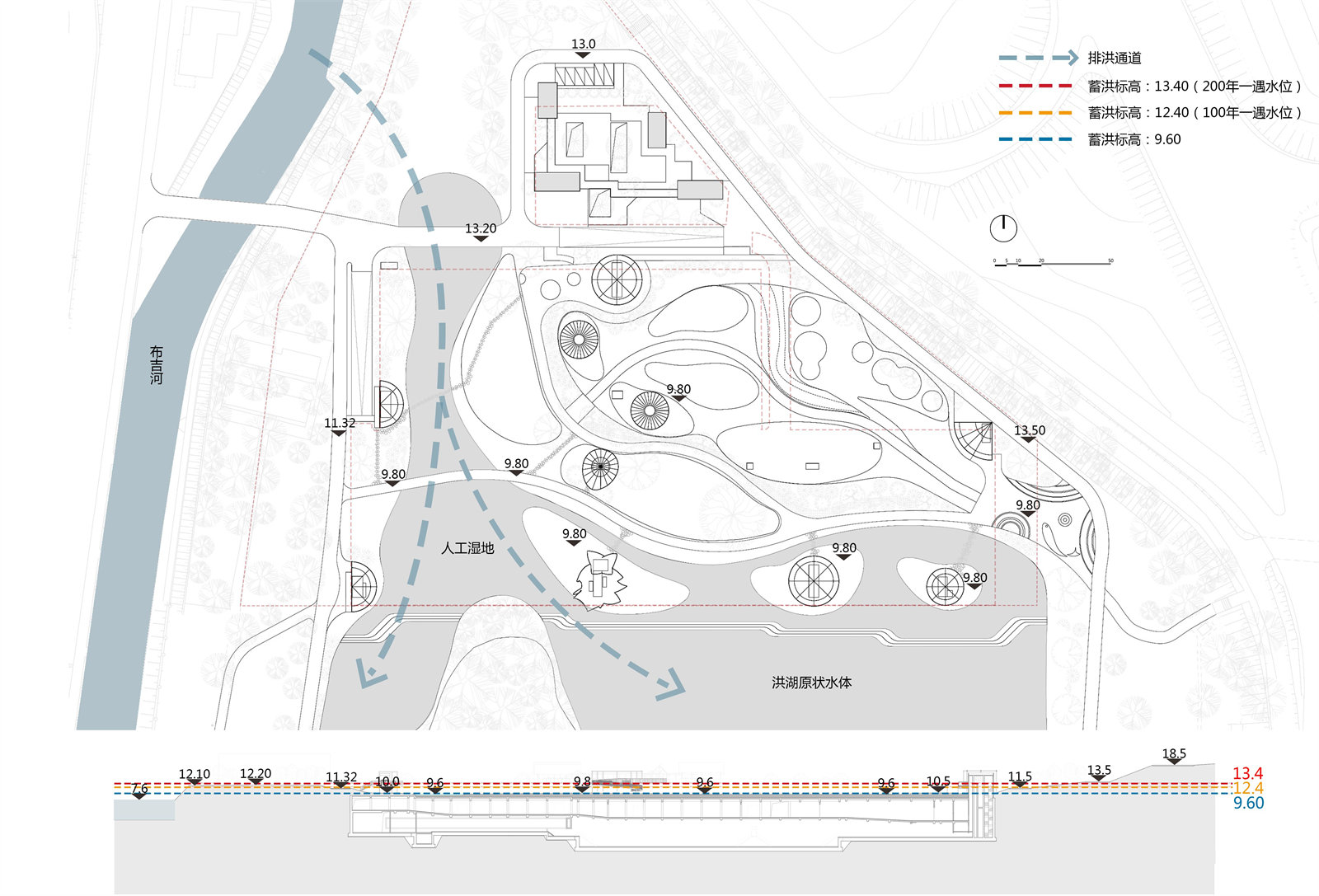
▼整體航拍: 突出地面的13個(gè)風(fēng)井 ?張超
Overall aerial photograph: 13 vent shafts protruding from the ground ? Zhang Chao
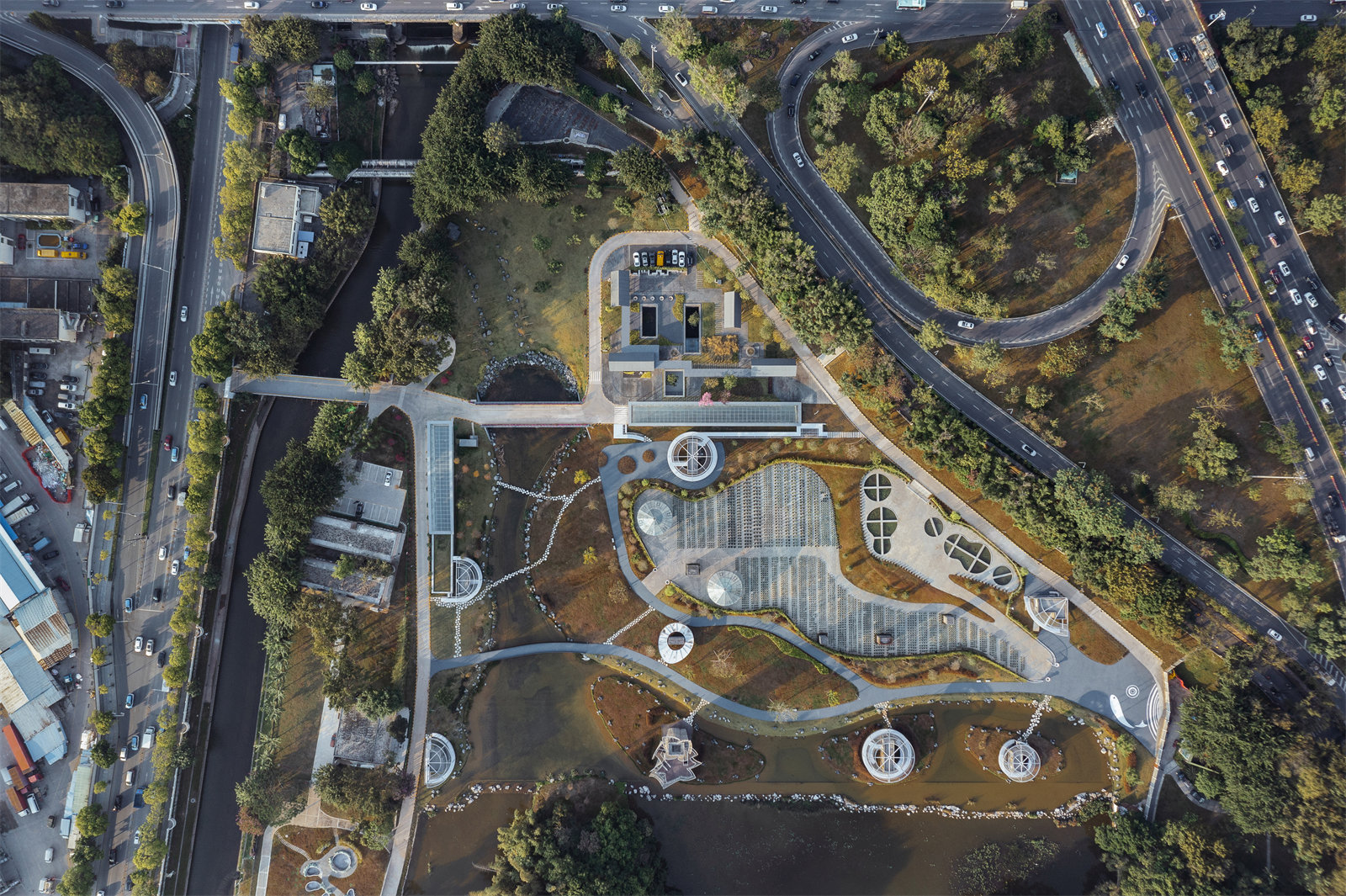
▼ 順應(yīng)場(chǎng)地,北側(cè)用自然疊水消化高差 ?張超
To adapt to the site, the north side uses natural water to digest the height difference ? Zhang Chao
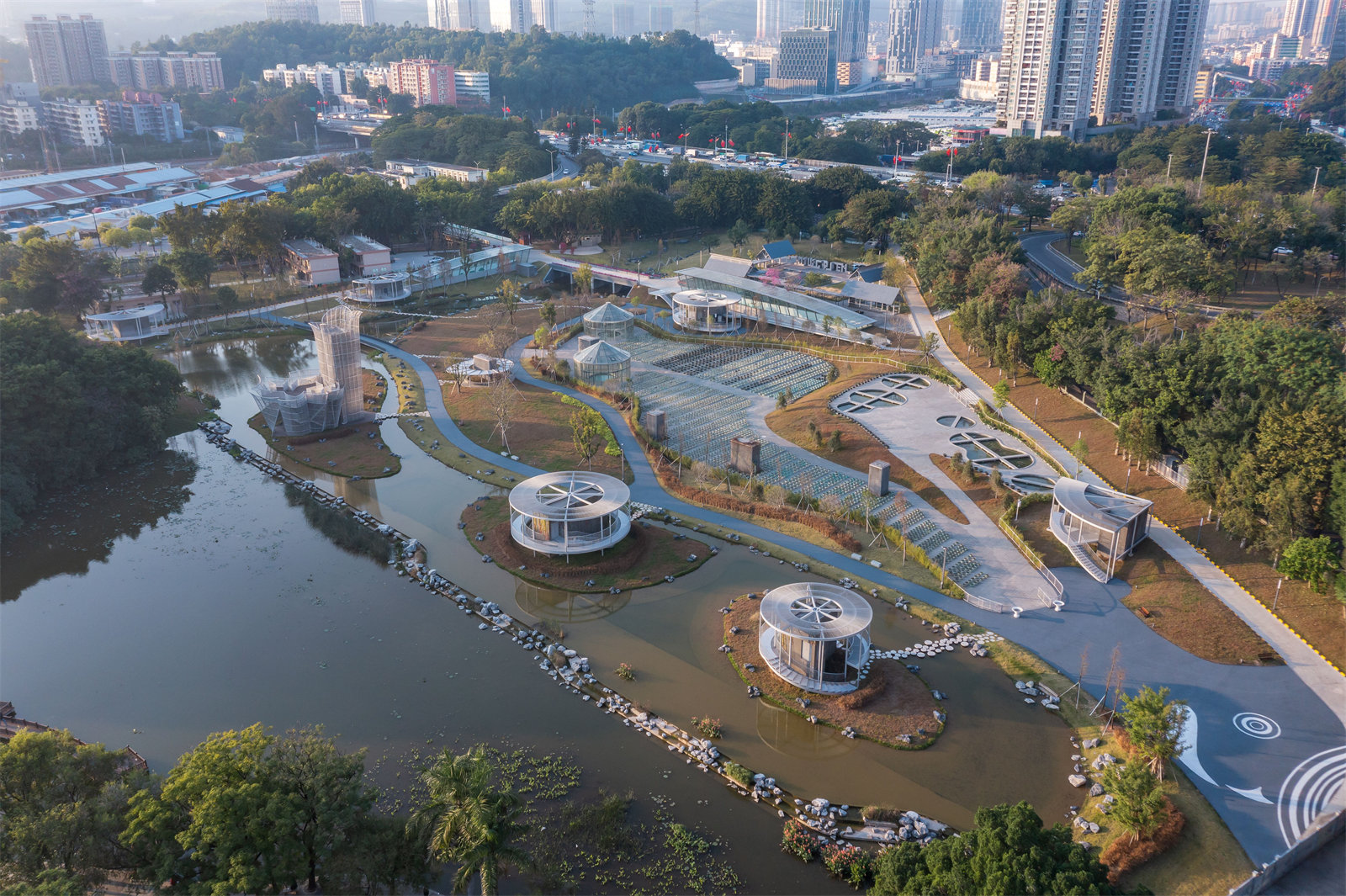
▼ 軸側(cè)功能圖 ?NODE
Axis Side function diagram ?NODE
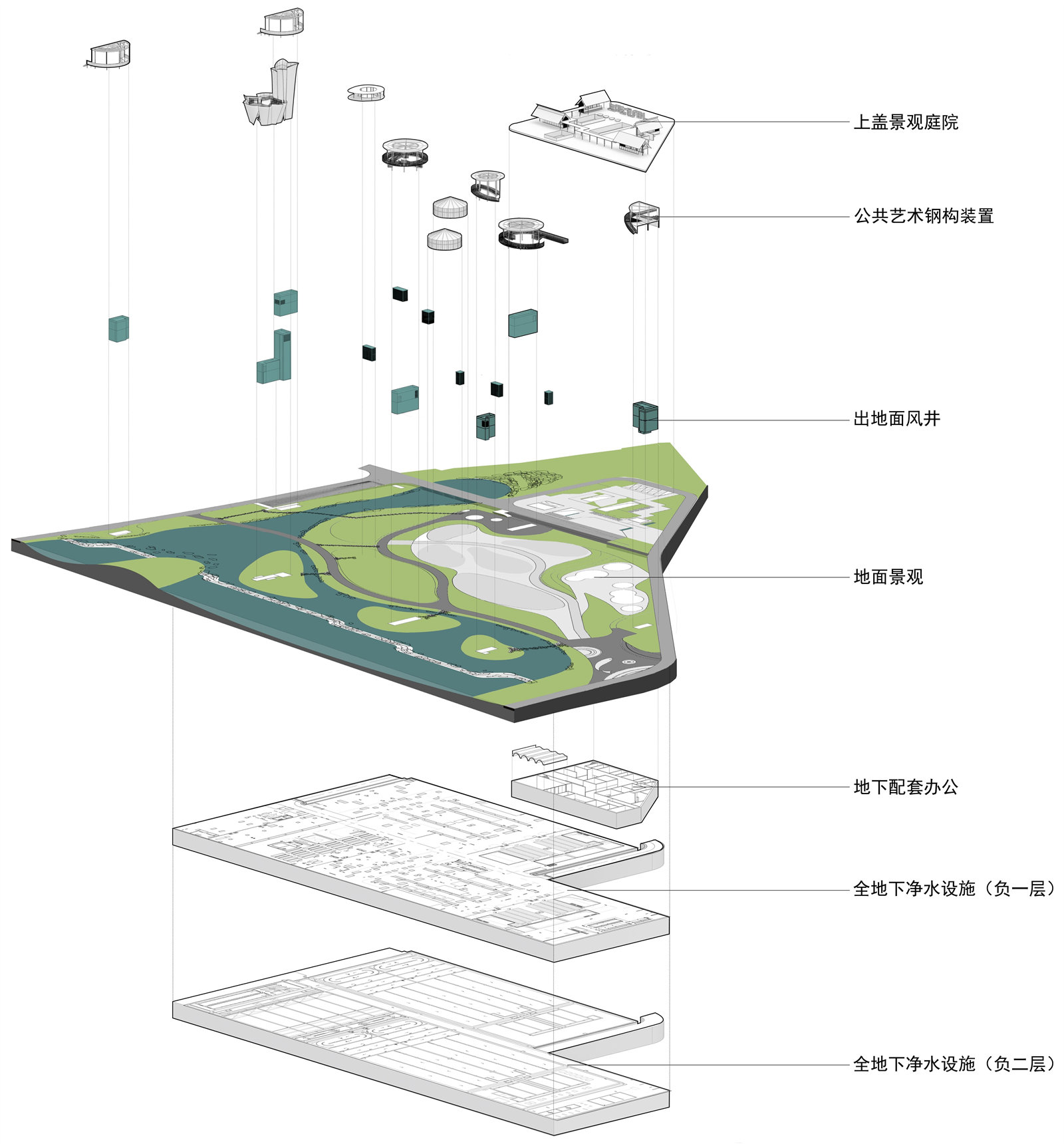
基礎(chǔ)設(shè)施的藝術(shù)裝置和公共化
Art Installation Treatment and Publicization of Infrastructure
兩層地下凈水廠的工程設(shè)計(jì)無(wú)疑在消防及排水等方面帶來(lái)與地面建筑不同的挑戰(zhàn)�。出地面風(fēng)井(部分含消防梯)大小共計(jì)13個(gè),大小高度不一�����,與公園生態(tài)環(huán)境格格不入���。公園方希望我們從原洪湖公園的嶺南園林特色中提取歷史符號(hào), 做直接的裝飾�����。但對(duì)我們而言, 不僅是簡(jiǎn)單“穿衣戴帽”的裝飾, 還是可以結(jié)合公共體驗(yàn)和自然教育等理念�����,在空間層次����、材料運(yùn)用及造型語(yǔ)言上做更深層的轉(zhuǎn)化�����?這是一個(gè)價(jià)值觀與設(shè)計(jì)的雙重問題��。我們嘗試對(duì)嶺南園林的“塔�����、亭����、榭、廊”空間原型進(jìn)行適度的設(shè)計(jì)研究和“元素”提取��,用當(dāng)代設(shè)計(jì)語(yǔ)言及材料去做轉(zhuǎn)化及表達(dá)����,同時(shí)結(jié)合景觀及植被特點(diǎn),將文化和自然特點(diǎn)有效結(jié)合起來(lái)���,嘗試化解基礎(chǔ)設(shè)施過于工程化的死板形象����。
The engineering design of the two-floor underground water treatment plant undoubtedly posed challenges different from those faced by surface buildings in terms of fire protection, drainage, etc,. In particular, thirteen vent shafts (some containing fire evacuation stairs) of different sizes and heights protruded out of the ground level, an inharmonious contract with the ecological environment of the park. The park management encouraged us to extract historical symbols from the Lingnan gardens of the former Honghu Park and use them as ornamental elements. But we must figure out whether ornaments were simple “addition of symbols”, or they could be transformed at a deeper level in terms of space, material and shape in combination with the concepts of public experience, natural education, etc. This was an issue about values and design. We conducted some design research on and “element” extraction from the original spaces of the “pagodas, pavilions, gazebos and corridors” of Lingnan gardens, and transformed and expressed them with contemporary design languages and materials. Then we incorporated the cultural and natural characteristics based on the landscape and vegetation characteristics, and tried to dissolve the stereotype of the infrastructure resulting from overemphasized engineering features.
▼ 風(fēng)井分布與公共裝置類型示意 ?NODE
Vent shaft distribution and public device type ?NODE

▼ 裝置概念演變 ?NODE
Device Concept Evolution ?NODE
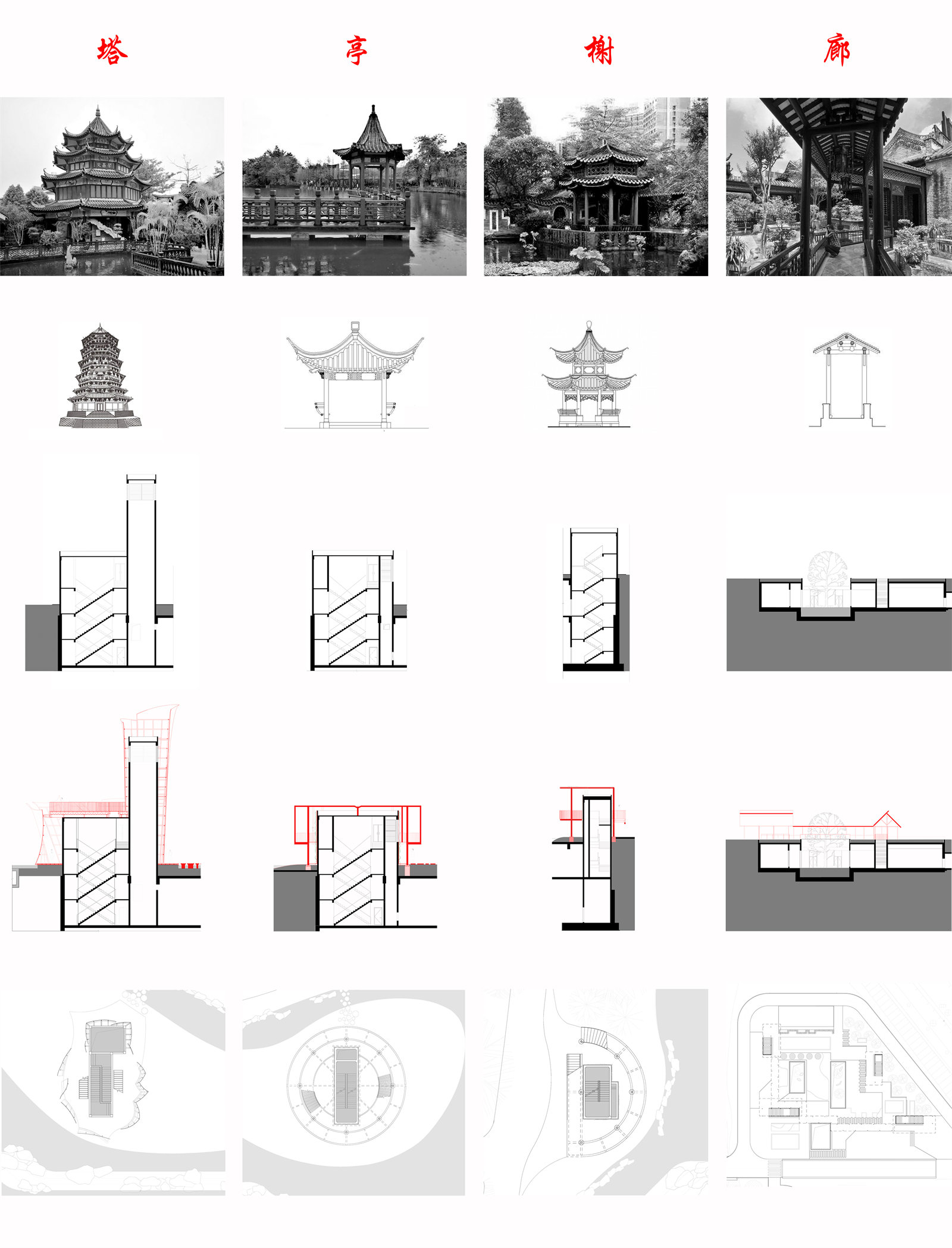
▼風(fēng)井與公共裝置軸側(cè)示意 ?NODE
Ventilation shaft and public device axis side diagram ?NODE
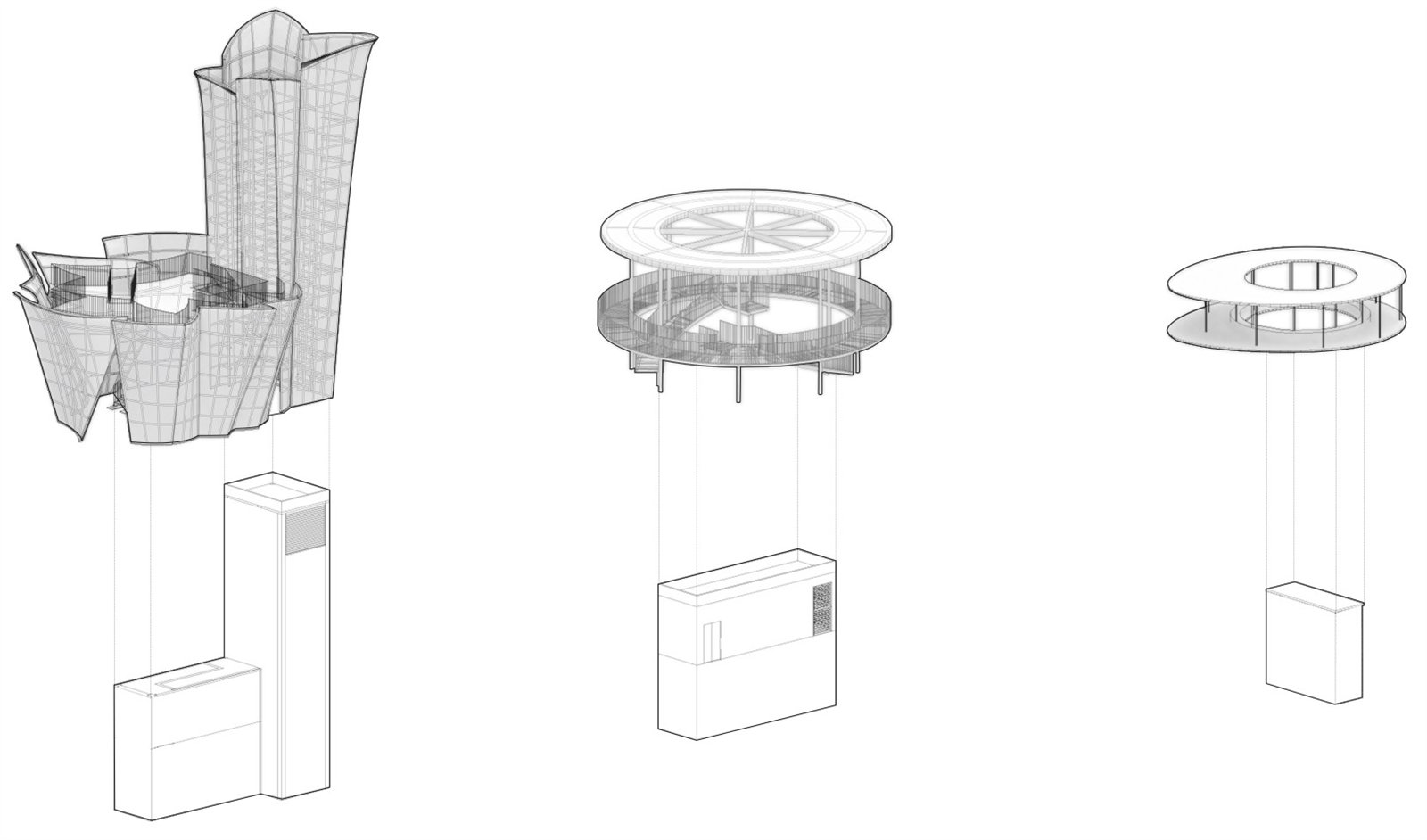
▼ 三種風(fēng)井裝置平面圖:#5風(fēng)井�,#12中型風(fēng)井,荷花塔 ?NODE
Three kinds of vent shafts device plan: #5 air shaft, #12 medium air shaft, Lotus tower ?NODE
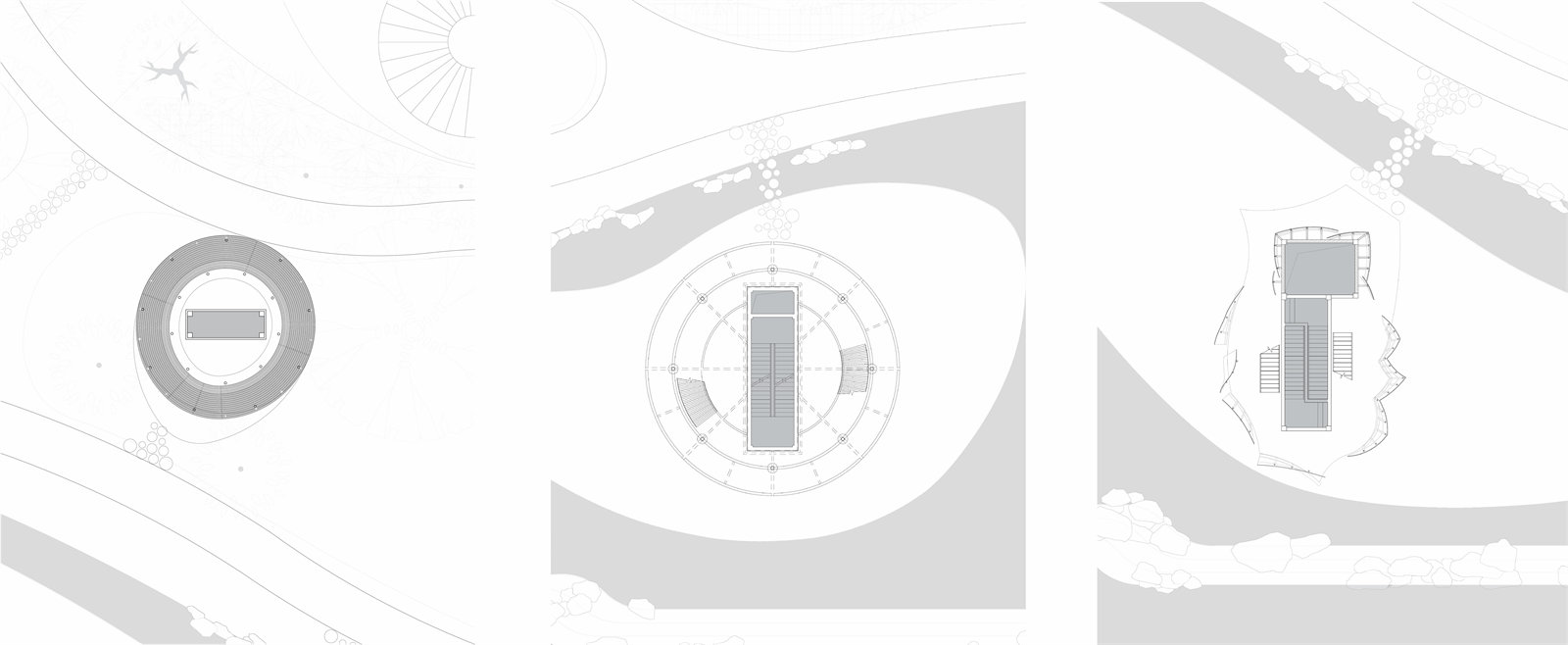
▼三種風(fēng)井裝置剖面圖:#5風(fēng)井��,#12中型風(fēng)井�����,荷花塔 ?NODE
Three kinds of vent shafts device plan: #5 vent shaft, #12 medium vent shaft, Lotus tower ?NODE

譬如,最高的除臭風(fēng)井離地面近16m��,我們順勢(shì)而為�����,融合公園方反復(fù)強(qiáng)調(diào)的主題植物——荷花的元素���,以公共藝術(shù)裝置作為設(shè)計(jì)切入點(diǎn)進(jìn)行三維抽象��,同時(shí)設(shè)置觀鳥觀景平臺(tái)���,消解了必要存在、但形象上突兀的風(fēng)井和疏散樓梯�����,使之成為“有用”的體驗(yàn)和洪湖公園重要的“荷花”地標(biāo)���。
For example, the highest deodorizing vent shaft was nealy16 m above the ground, and we naturally made it a 3D abstraction of lotus, the theme plant repeatedly emphasized by the park management, and a public art installation. The bird watching and observation platform helped eliminate the compulsory but visually-awkward vent shafts and evacuation stairs, injecting“useful” experience in them and creating an important lotus landmark in Honghu Park.
▼ 最高風(fēng)井裝置——荷花塔 ?張超
The highest vent shaft device -- Lotus Tower ? Zhang Chao
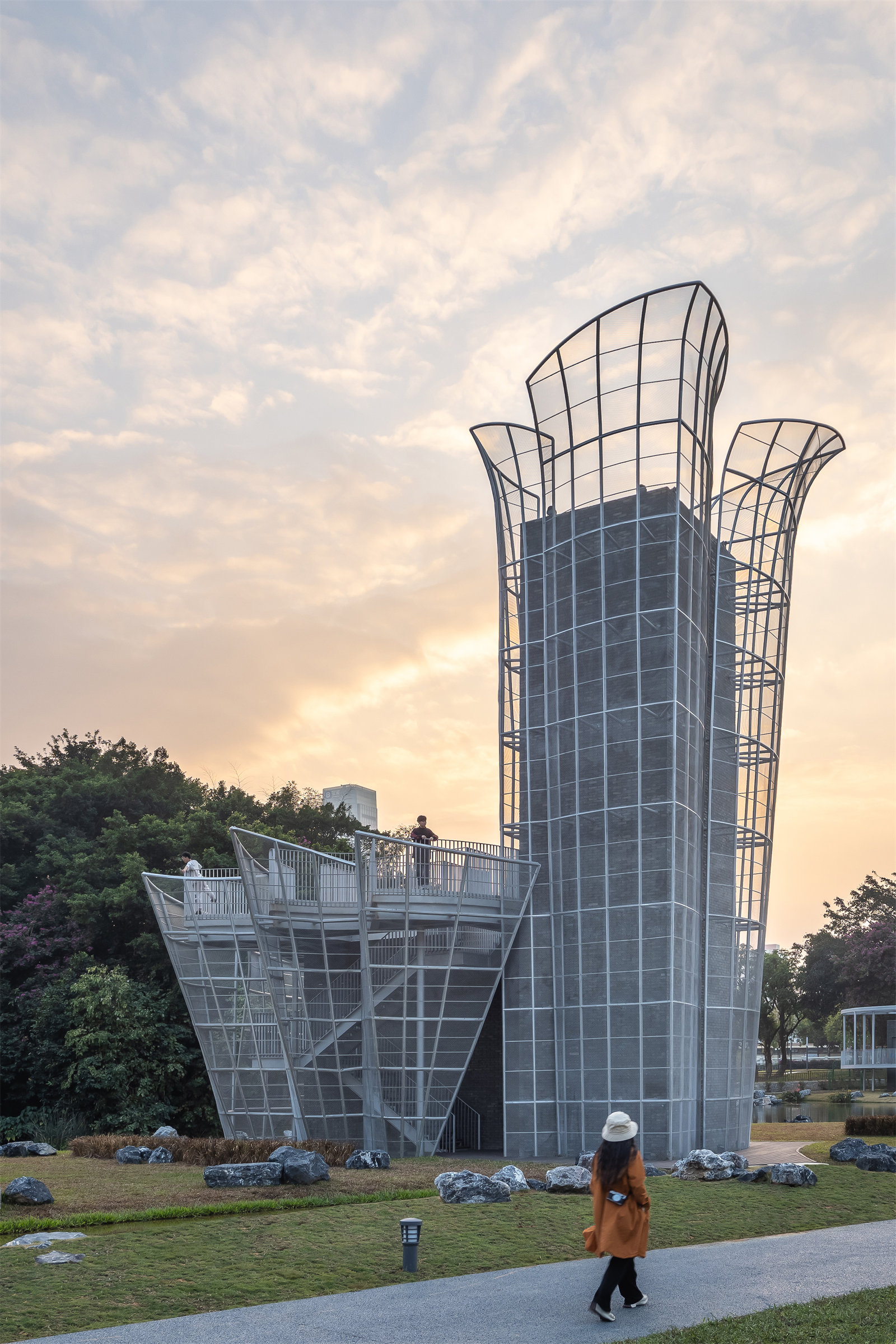
▼荷花塔——樓梯上至平臺(tái) ?張超
Lotus Tower -- Stairway to platform ?Zhang Chao


▼荷花塔—細(xì)部結(jié)構(gòu) ?張超
Lotus Tower—Detail structure ?Zhang Chao

6個(gè)中型風(fēng)井��,結(jié)合疏散樓梯的功能����,我們兼容了可上人體驗(yàn)的路徑及平臺(tái)�,空間形態(tài)上也各有特點(diǎn)。其他6個(gè)小型風(fēng)井立面上只簡(jiǎn)單采取景觀覆綠和成為公園的避雨亭�����。在整個(gè)設(shè)計(jì)過程中����,雖然地下工程不可避免地有不少意料之外的元素“被告知”,但我們一直努力避免過度設(shè)計(jì):既不凸顯��,也無(wú)需遮掩����,盡量因勢(shì)利導(dǎo),自然統(tǒng)一和諧�。
The six medium-sized vent shafts containing evacuation stairs were designed with accessible paths and platforms, reflecting different characteristics in spatial form. The six small ones were dedicated for ventilation, so only facade greening on grilles of similar materials were employed to enhance the natural feel, including a rain shelter with seats. During the whole design process, we’ve been trying to avoid excessive design despite of many unexpected factors “informed” about the underground works. We neither highlight nor cover up, but instead, we made the best out of the project conditions to achieve natural unity and harmony.
▼ 通過水上汀步走入風(fēng)井 ?張超
Walk through the water into the vent shaft ?Zhang Chao
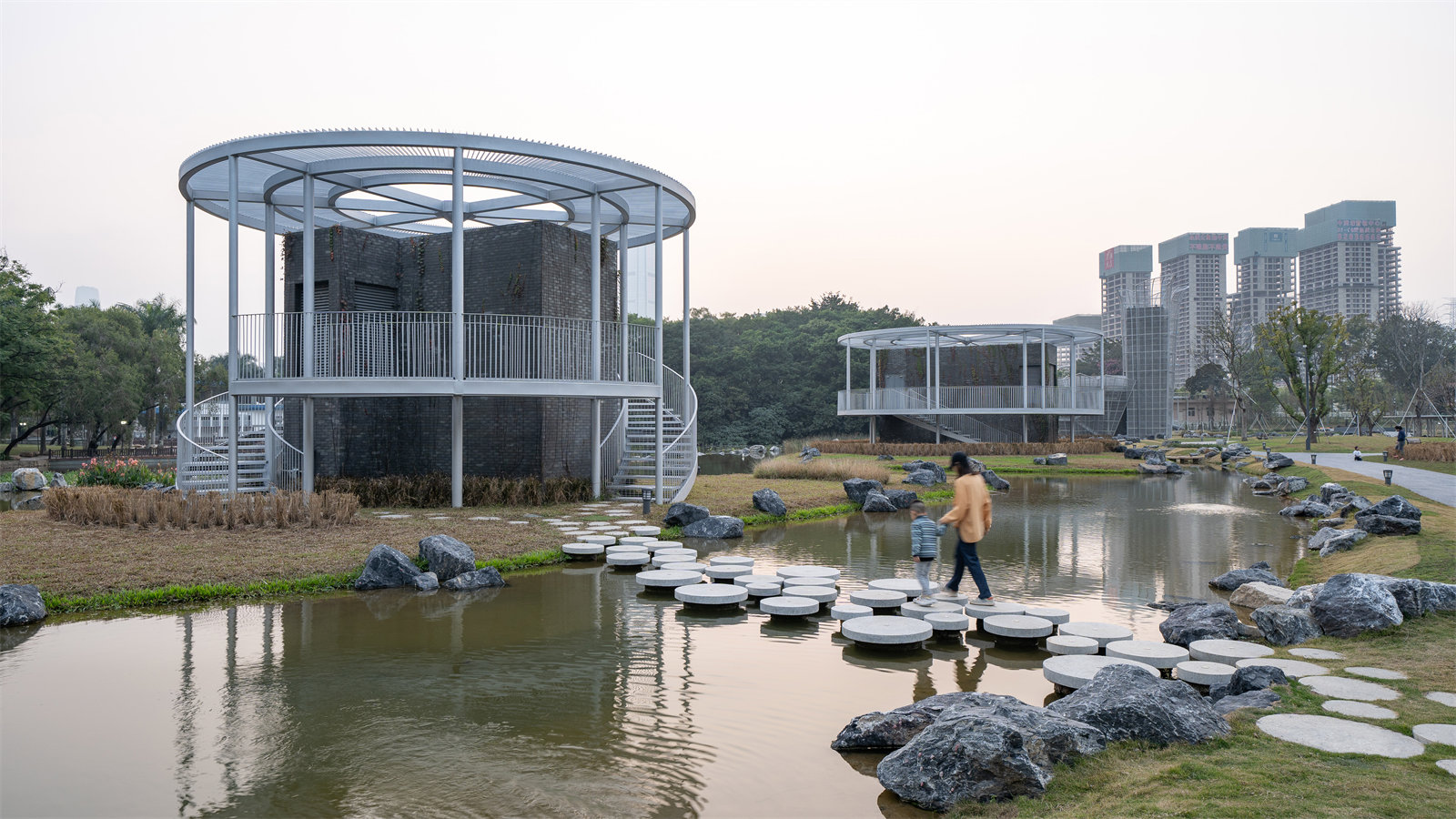
▼輕盈鋼結(jié)構(gòu)包裹風(fēng)井 ?張超
Light steel structure wraps the vent shaft ?Zhang Chao
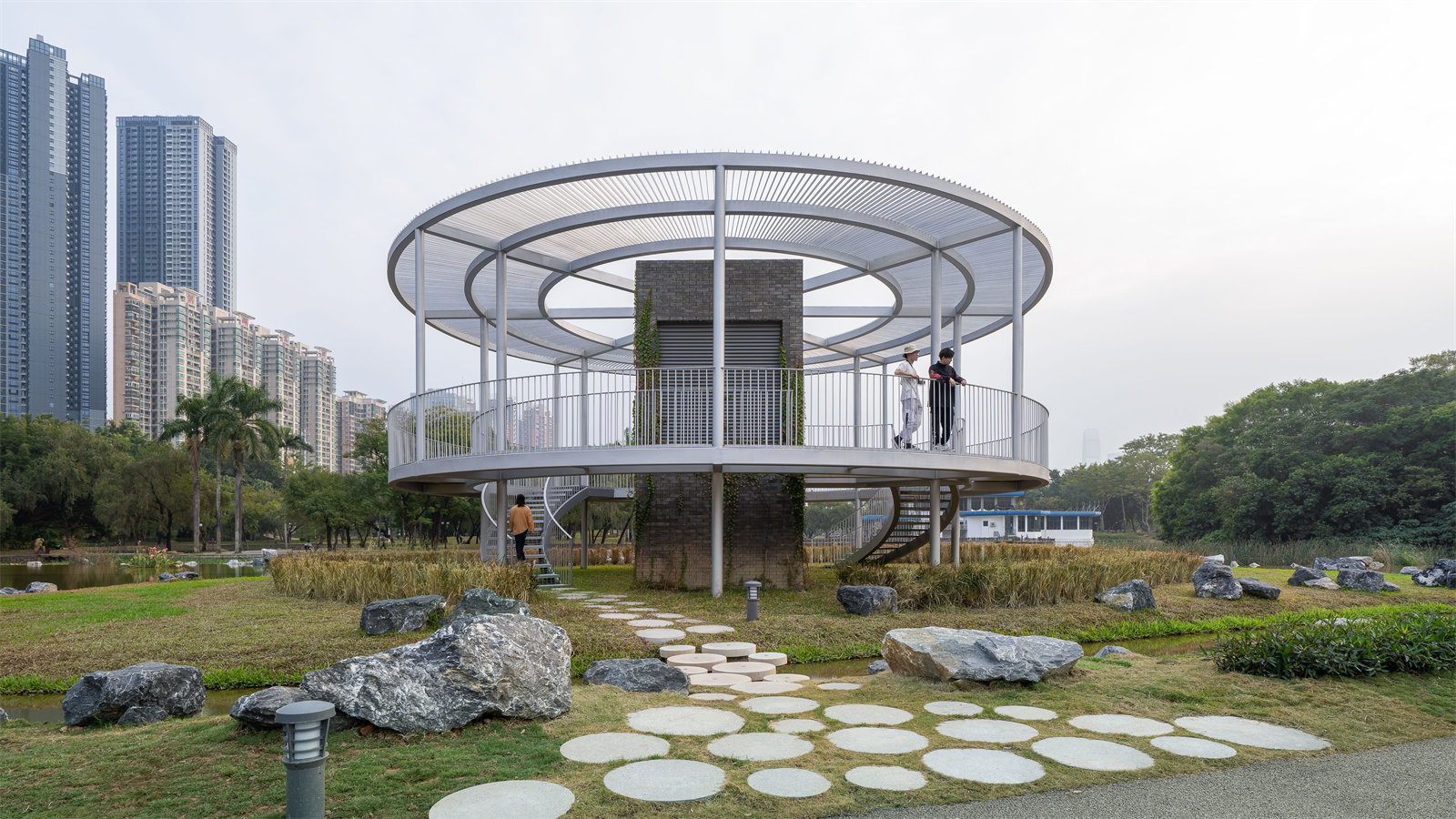
▼ 地面步行系統(tǒng) ?張超
Ground walking system ?Zhang Chao

▼ 慢行體驗(yàn)小徑 ?張超
Slow trail ? Zhang Chao

地下配套建筑:園林的顯性與隱性呈現(xiàn)
Underground Supporting Building: Explicit and Implicit Presentation of Gardens
北端地下配套建筑整體主要功能為辦公空間,因其位于洪湖公園的末端���,位置較偏����。如何創(chuàng)造足夠的吸引力,引導(dǎo)公眾發(fā)現(xiàn)并步行而至��,這是個(gè)關(guān)鍵的設(shè)計(jì)問題��。在此���,我們采取了“軟硬兼施”的設(shè)計(jì)策略:一方面是在辦公功能之外�����,增加公共教育及科普功能�,例如結(jié)合地下開放花園���,設(shè)置一個(gè)可對(duì)公眾開放的凈水科普展廳��;另一方面����,在地面層�,嘗試做出一個(gè)有特色的公共空間及園林作為景觀亮點(diǎn)及展廳的暖場(chǎng)區(qū)域,以吸引人流��。The northernmost underground supporting building was planned as office space. As it stood at the end of the Park, geographically out of the way, how to create enough magnets to guide the public to discover and walk to it became a key design issue. As response, we adopted a design strategy that emphasizes both software and hardware. On the one hand, we added the functions of public education and science popularization on top of office function, such as creating a water purification exhibition hall in combination with the underground open garden; on the other hand, we tried to create a distinctive public space and garden on ground level as the landscape highlight and the pre-function zone of the exhibition hall to attract people.
▼ 北側(cè)配套辦公區(qū) ?張超
Supporting Office area in the north ?Zhang Chao
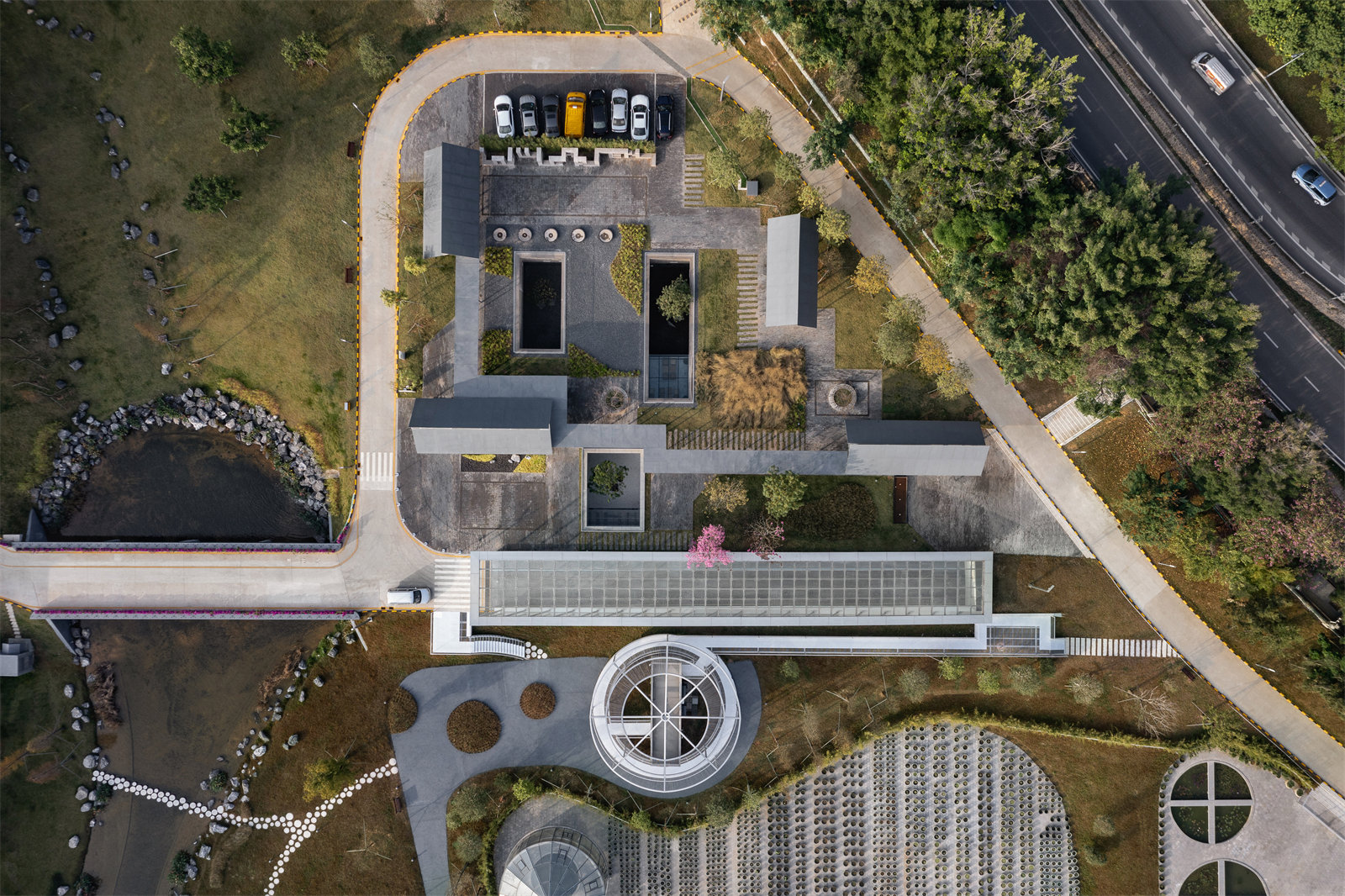
▼配套辦公區(qū)——地面園林景觀 ?張超
Supporting office area — ground landscape garden ?Zhang Chao
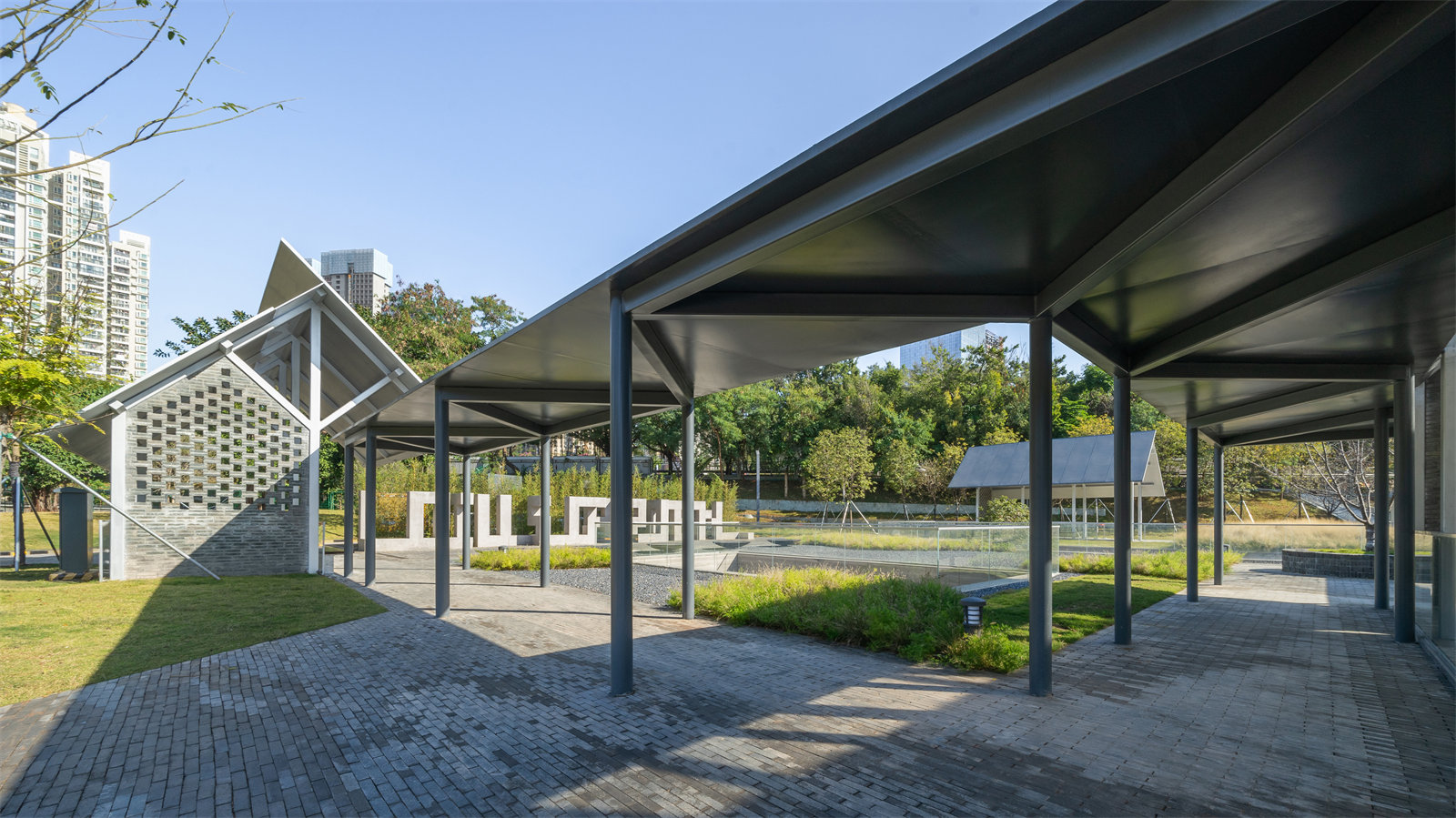
▼ 配套辦公區(qū)——地面園林廊亭 ?張超
Supporting Office Area -- Ground garden Gallery ? Zhang Chao

在這里,我們順延整體造園的概念���,結(jié)合當(dāng)代的造型語(yǔ)言及建構(gòu)形式�,以“亭廊”作為基本的�����、顯性的空間要素�,圍繞地下開放花園����,連接通往地下公共展廳及辦公空間的流線,既致敬經(jīng)典�����,又適當(dāng)創(chuàng)新�����,形成一個(gè)曲徑通幽����、靜謐又稍帶神秘感的上蓋花園。
Here, we extended the gardening concept. With reference to the contemporary formal language and constructional forms, we arranged the basic and explicit spatial elements of “pavilion and corridor” around the the underground open garden, and connected them with circulations to the underground public exhibition halls and office spaces. This approach, both a tribute to the classic precedents and a proper innovation, helped create a secluded, quiet and slightly mysterious surface garden.
▼ Logo景觀墻概念效果示意 ?NODE
Concept effect of Logo Landscape wall ?NODE
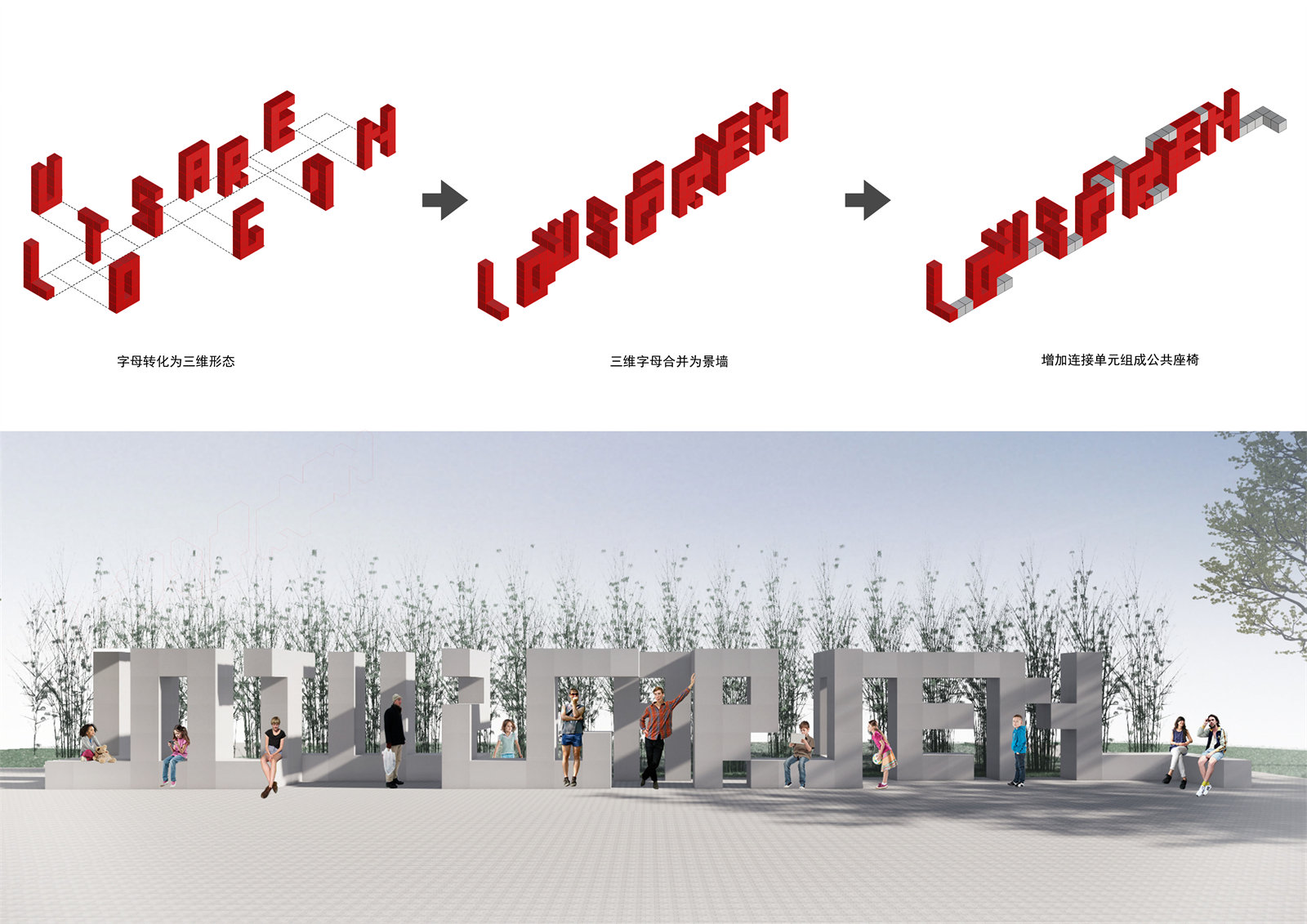
▼ 景墻實(shí)景 ?張超
Landscape Wall ?Zhang Chao
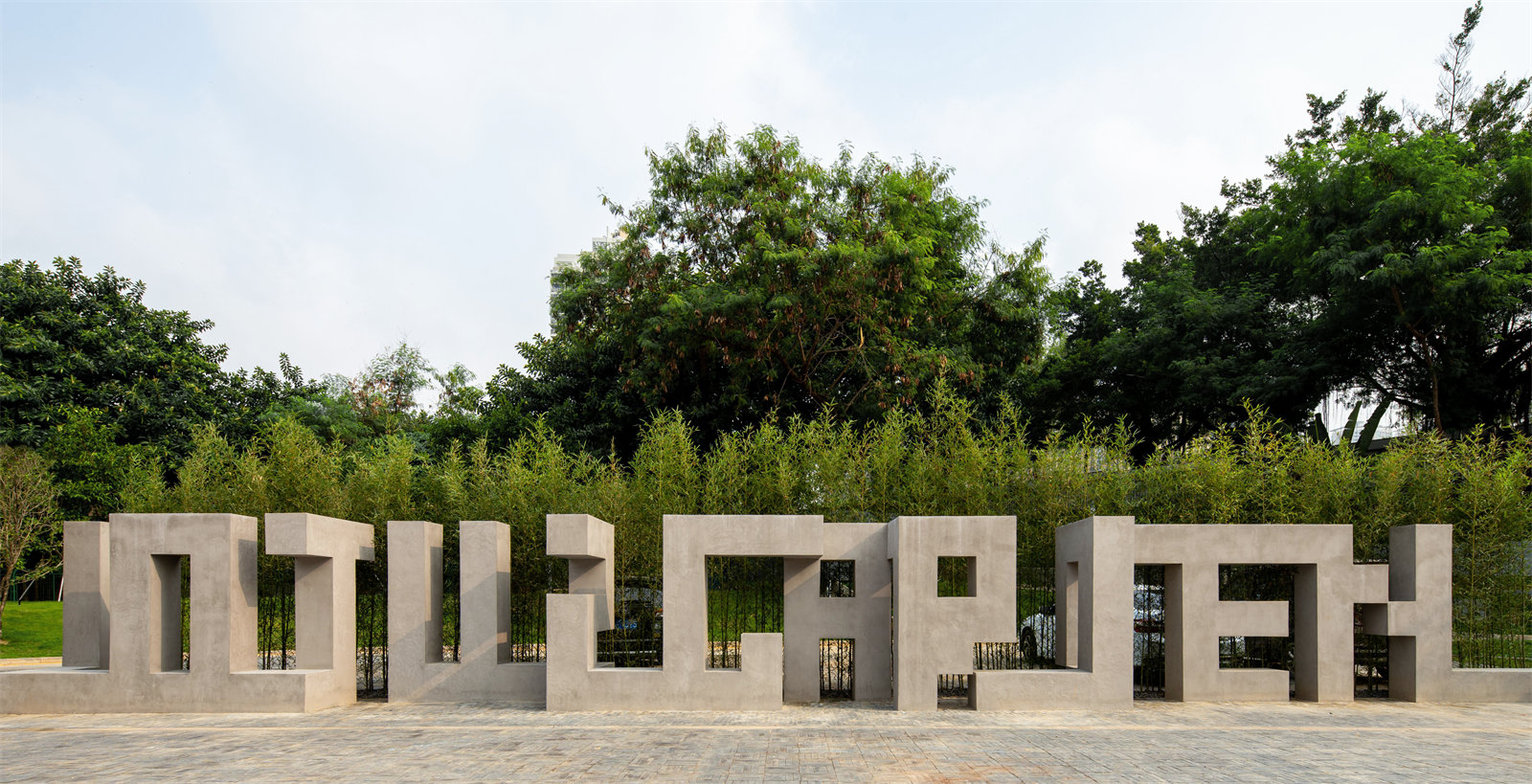
04 結(jié)語(yǔ)
04 Conclusions
這個(gè)項(xiàng)目從我們開始介入地面景觀設(shè)計(jì)到完工,歷時(shí)四年有余�,無(wú)論是生產(chǎn)工藝及景觀建筑設(shè)計(jì)的跨界和方法論,還是對(duì)專業(yè)設(shè)計(jì)及施工質(zhì)量有共同的標(biāo)準(zhǔn)共識(shí)�,仍任重而道遠(yuǎn),尚需共同努力����。
洪湖公園地下水質(zhì)凈化廠及地面景觀恢復(fù)項(xiàng)目完成后,很榮幸地被提升命名為“深圳荷水文化基地”�����。這是南沙原創(chuàng)團(tuán)隊(duì)多年來(lái)在基礎(chǔ)設(shè)施公共化系列里�����,對(duì)凈水生產(chǎn)與景觀建筑跨界設(shè)計(jì)實(shí)踐的另一次重要嘗試���。一如既往��,我們希望通過景觀/建筑師主動(dòng)的設(shè)計(jì)努力����,讓一個(gè)日常生活中無(wú)法缺席的工程凈水生產(chǎn)設(shè)施���,成為城市中一個(gè)良好的��、帶有儀式感的公共體驗(yàn)和教育場(chǎng)所���,重新賦予基礎(chǔ)設(shè)施在精神和景觀/建筑美學(xué)兩個(gè)維度的意義�����。
The project lasted four years from the commencement of our surface landscape design to the project completion. However, for such infrastructure projects posing major engineering and aesthetic challenges, the consensus and cooperation among different disciplines and professional practices cannot be reached overnight. In fact, there is still a long way for us to go, and all stakeholders need to work together toward this goal.Upon its completion, the project was renamed as Shenzhen Lotus Water Culture Base. It represents another important attempt of NODE team in infrastructure publicization projects over the years in terms of interdisciplinary design practice of water purification and landscape architecture. As always, we hope that, through the active design efforts of landscape architects/architects, the water purification facilities that are indispensible for our daily life will become pleasant and ceremonial places in the city for public experience and learning, thus redefine the significance of infrastructure from the dimensions of spirit and landscape/architectural aesthetics.
▼夕陽(yáng)中的荷花塔與風(fēng)井 ?張超
Lotus Tower and Vent Shaft in sunset ? Zhang Chao
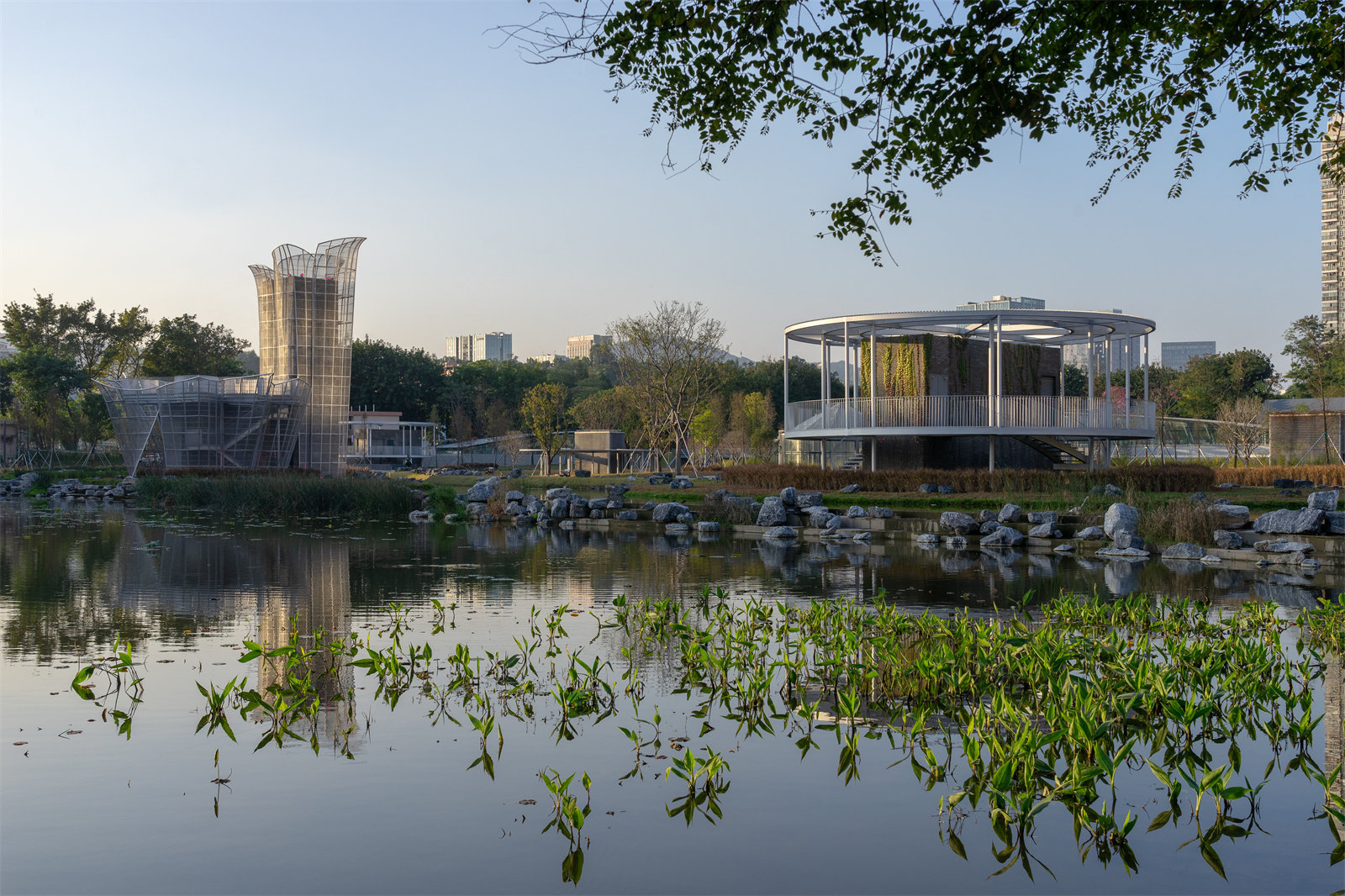
▼夜景 ?張超
Night view ? Zhang Chao
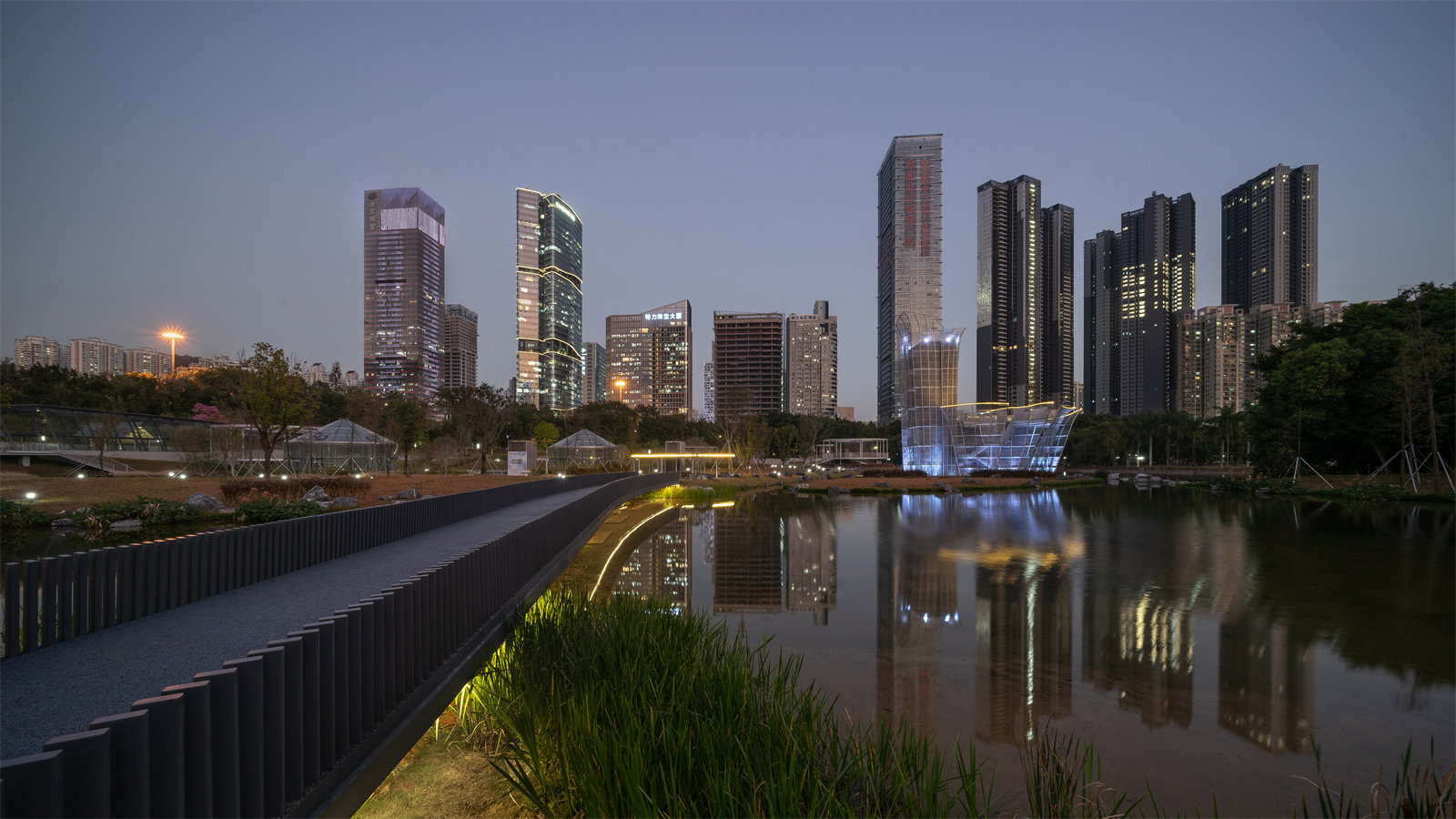
設(shè)計(jì)圖紙
▼ 總平面圖 ?NODE
Master plan ?NODE
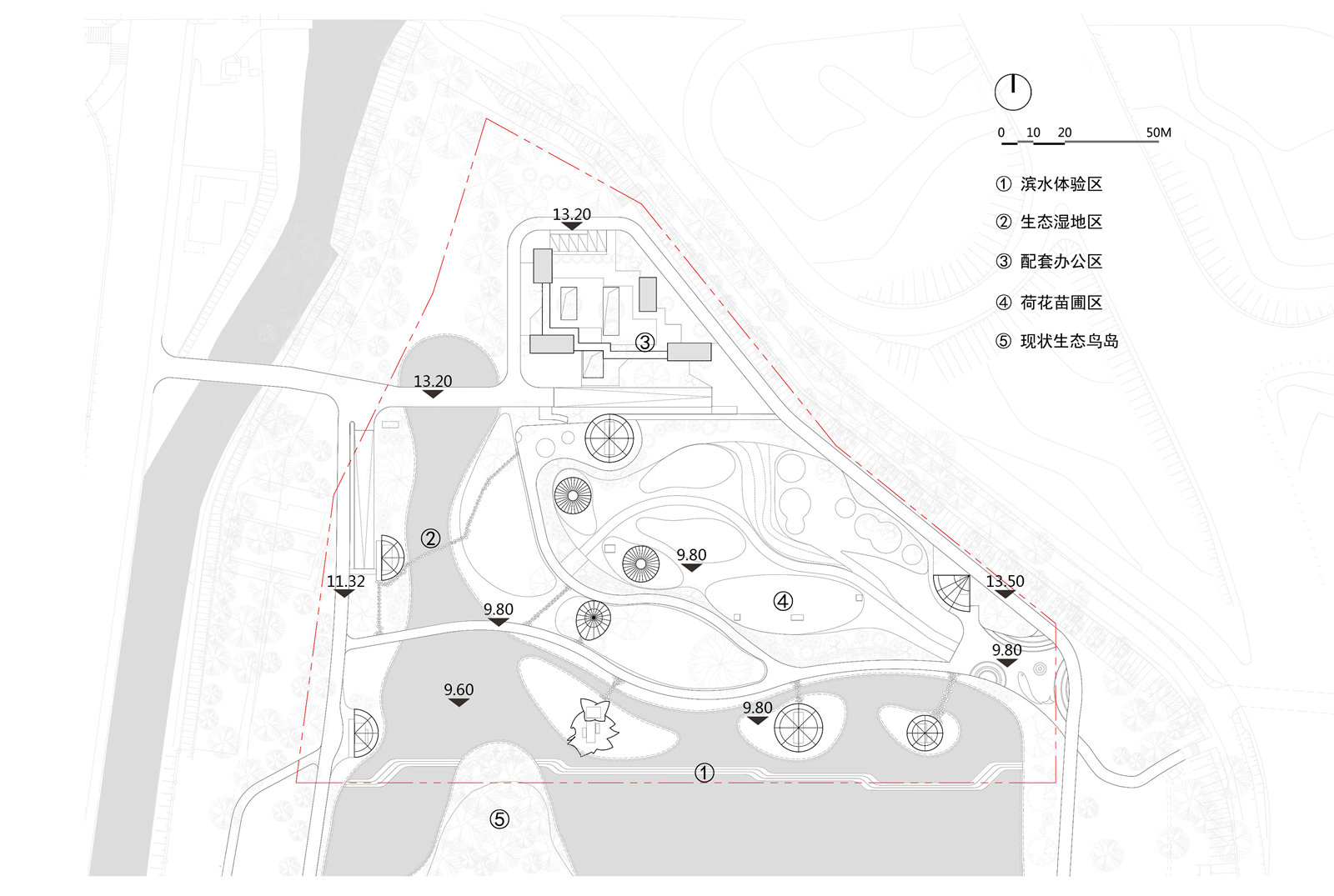
▼ 總剖面圖 A-A ?NODE
Section A-A ?NODE
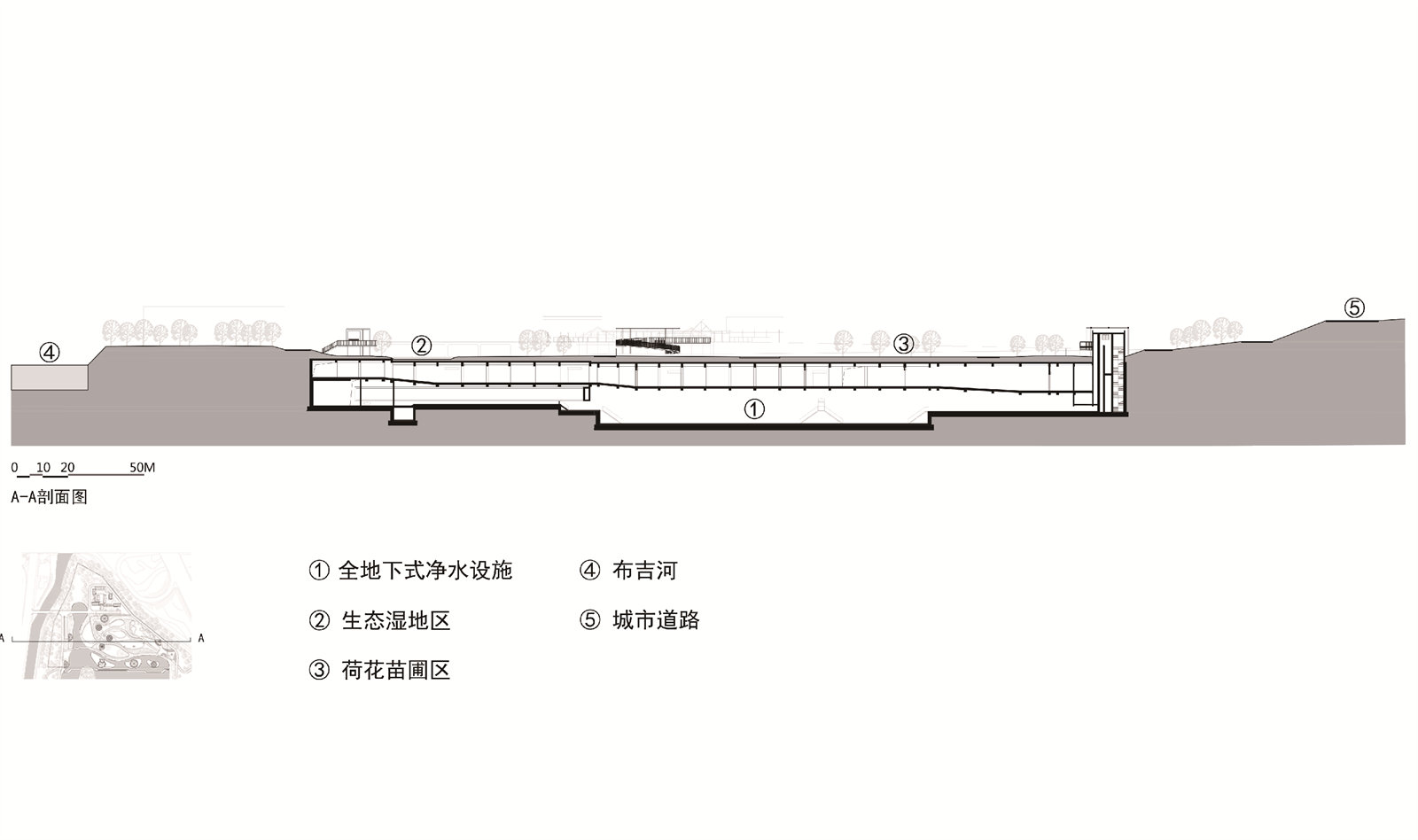
▼ 總剖面圖B-B ?NODE
Section B-B ?NODE
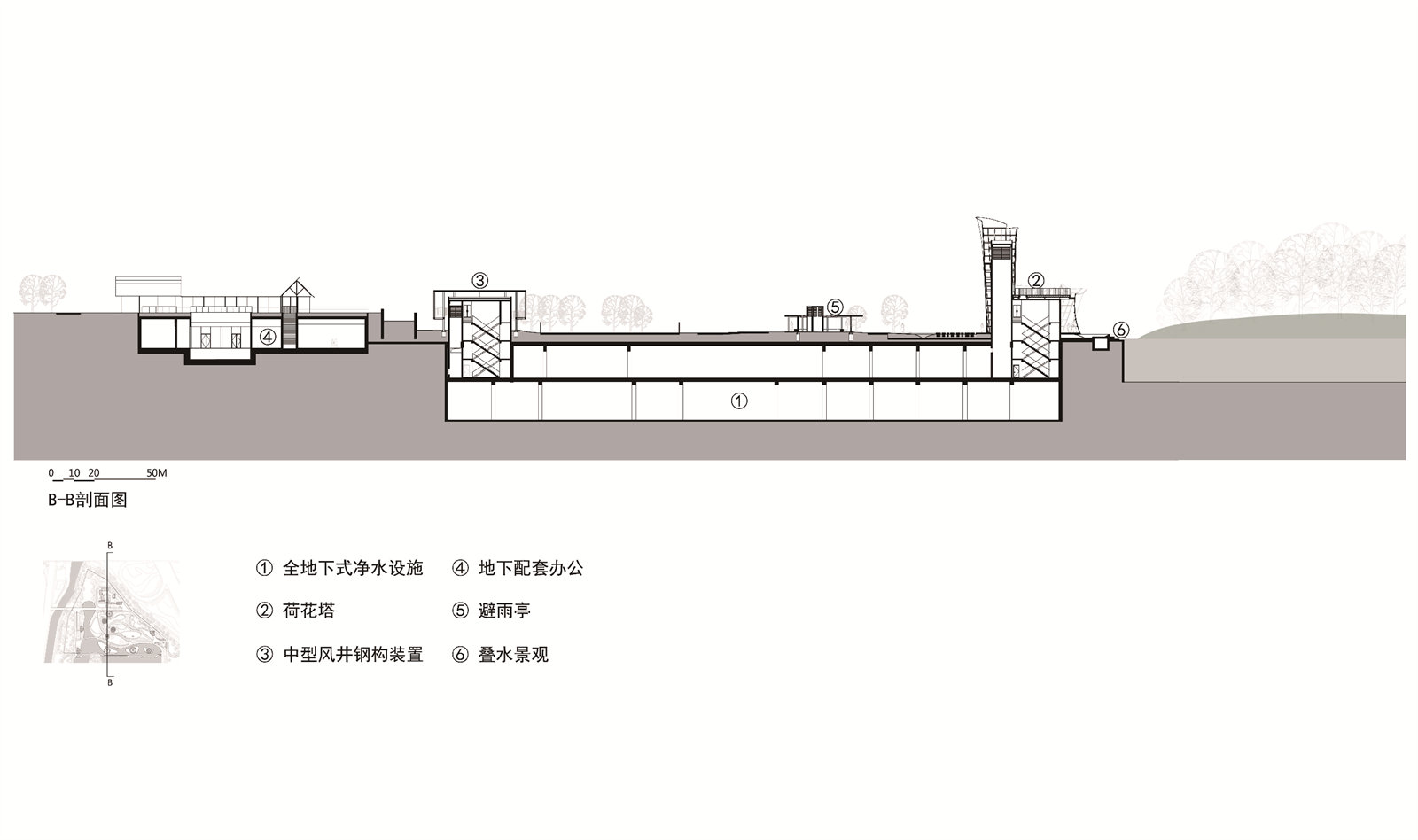
▼配套辦公區(qū)平面圖 ?NODE
Plan of supporting Office Area ?NODE

▼ 配套辦公區(qū)(-1F)平面圖 ?NODE
Supporting Office Area (-1F) Plan ?NODE

▼配套辦公區(qū)剖面圖1-1 ?NODE
Profile of supporting office area 1-1 ?NODE
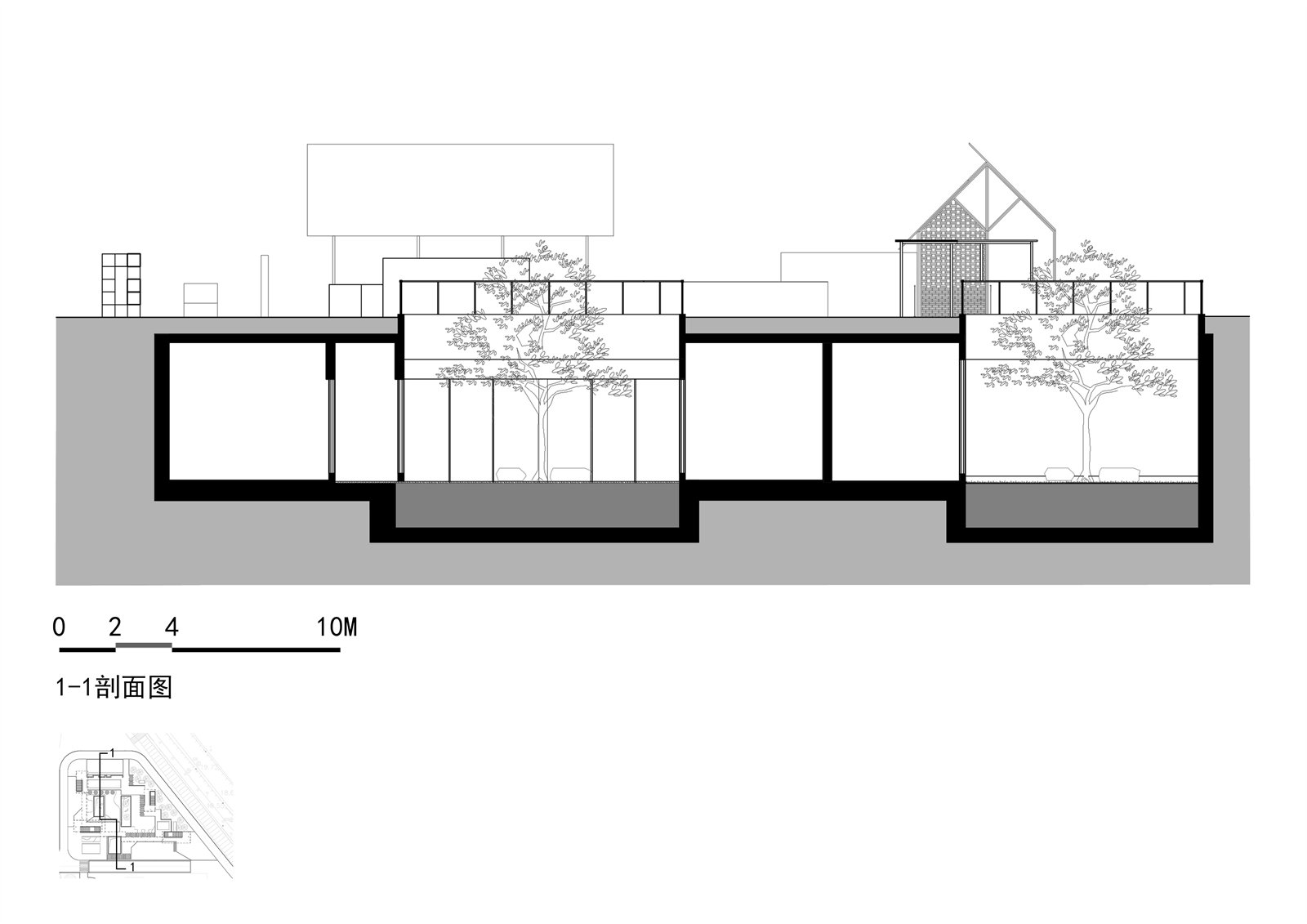
▼配套辦公區(qū)剖面圖2-2 ?NODE
Profile of supporting office area 2-2 ?NODE
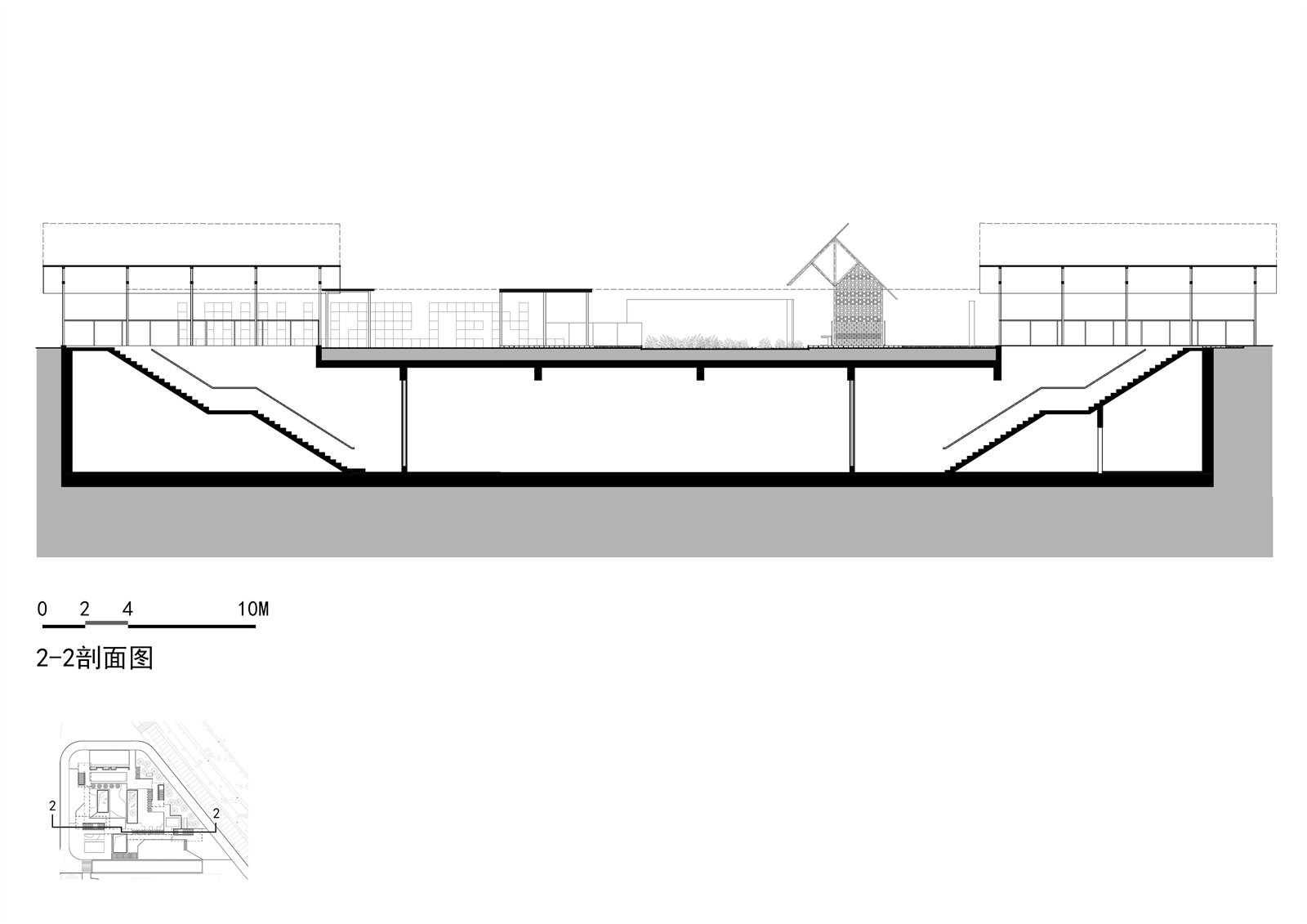
▼ 配套辦公區(qū)廊亭大樣 ?NODE
Supporting office Area Gallery Pavilion layout ?NODE

▼荷花塔平面圖 ?NODE
Plan of lotus Tower ?NODE
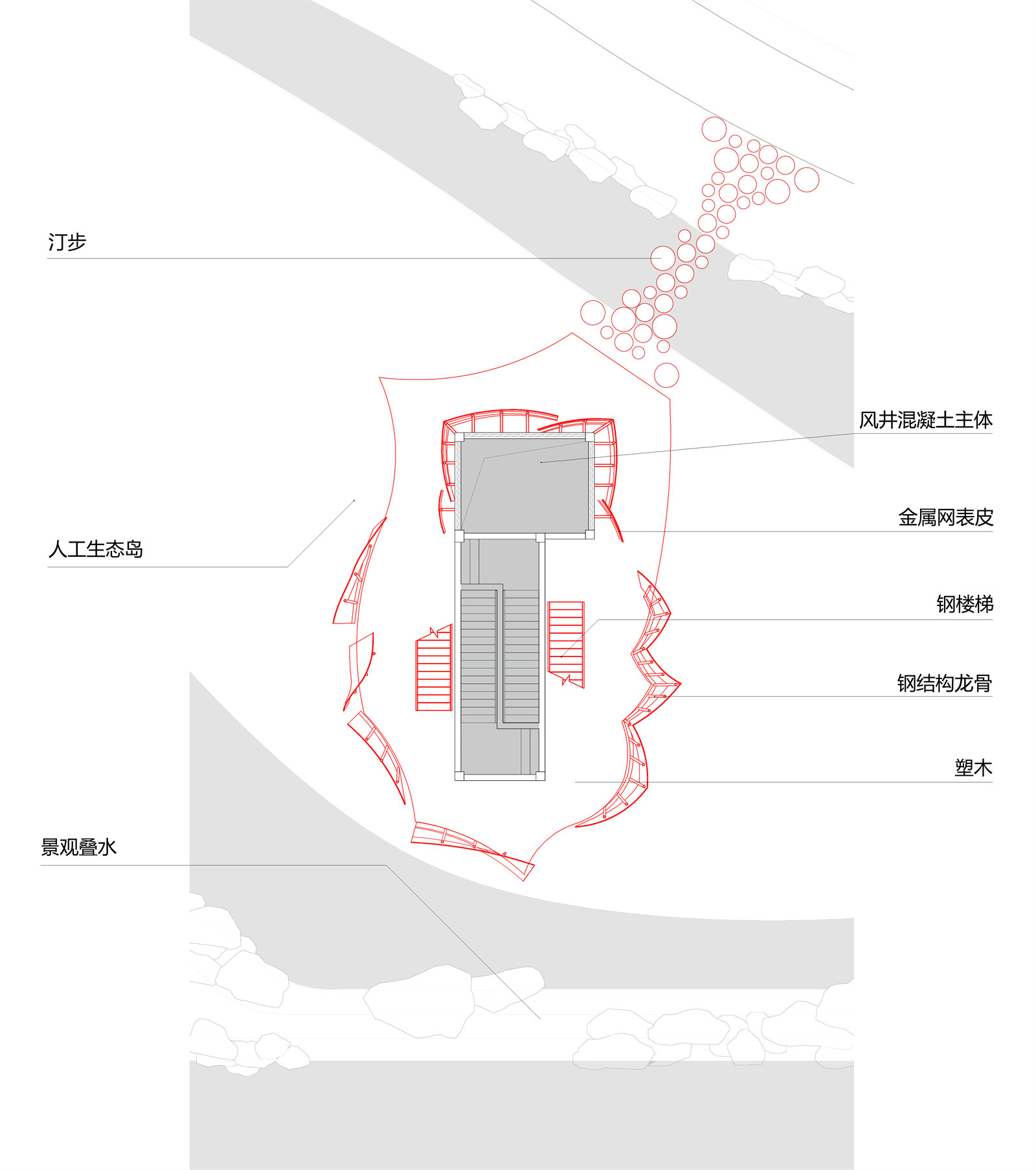
▼荷花塔剖面圖 ?NODE
Lotus Tower section ?NODE
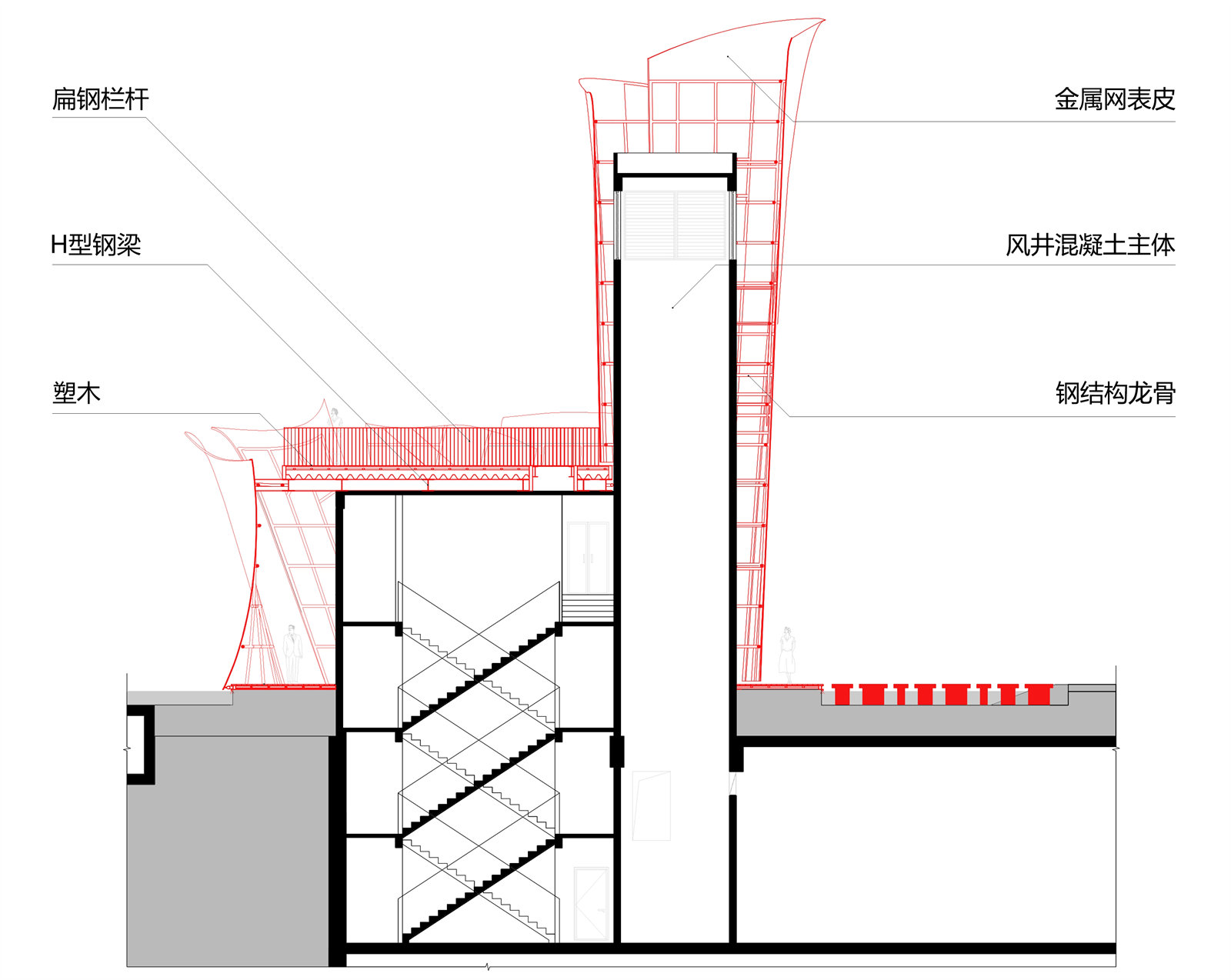
▼ 風(fēng)井平面圖 ?NODE
Vent shaft plan ?NODE

▼風(fēng)井剖面圖 ?NODE
Ventilation shaft profile ?NODE
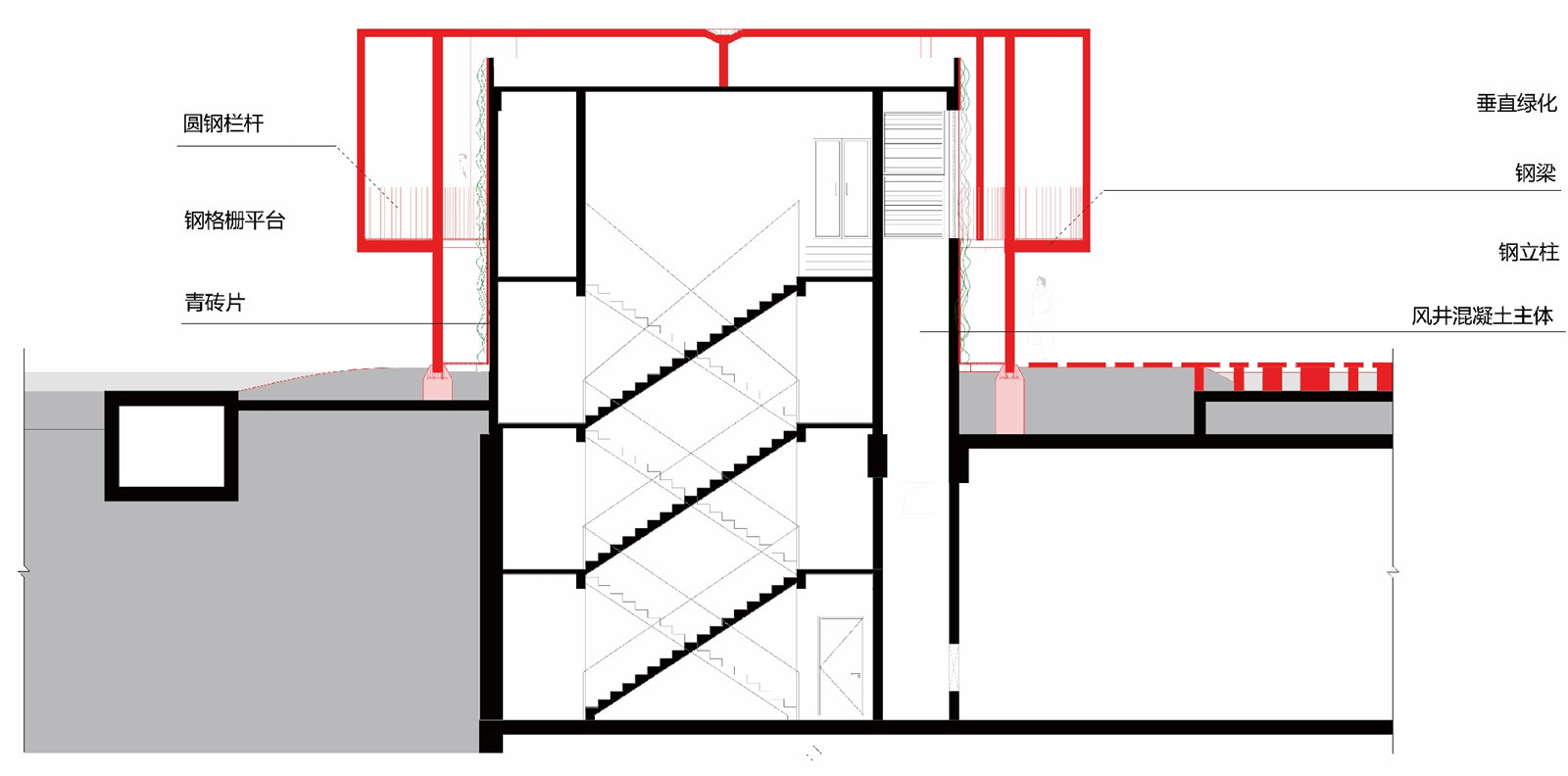
▼樓梯大樣 ?NODE
Stair details ?NODE
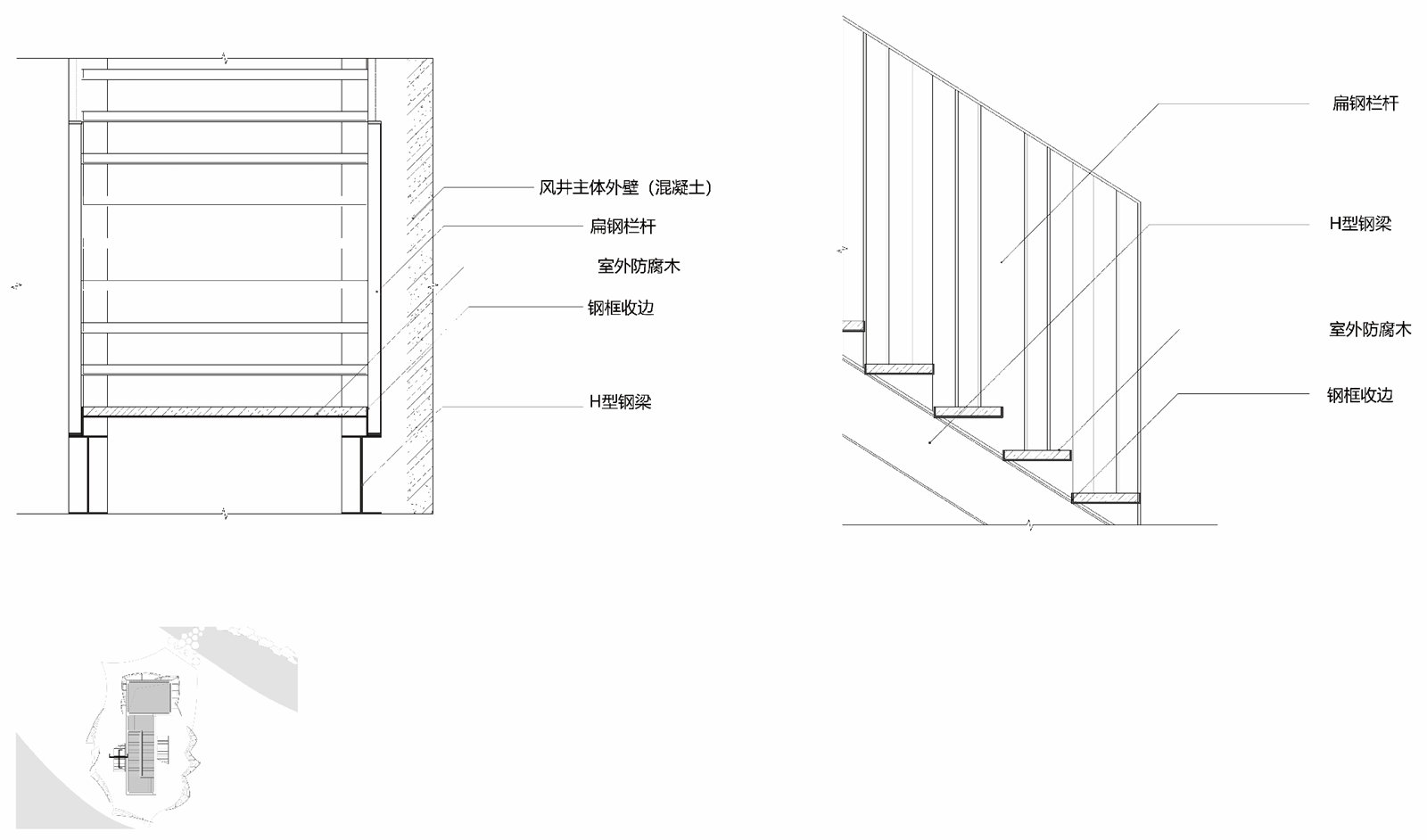
▼疊水剖面大樣 ?NODE
Large sample of superimposed water section ?NODE

項(xiàng)目信息
項(xiàng)目名稱 : 深圳荷水文化基地暨洪湖公園水質(zhì)凈化廠上部景觀設(shè)計(jì)
項(xiàng)目類型:基礎(chǔ)設(shè)施
項(xiàng)目地點(diǎn):深圳市羅湖區(qū)
設(shè)計(jì)單位:南沙原創(chuàng)建筑設(shè)計(jì)工作室
主持建筑師:劉珩
設(shè)計(jì)團(tuán)隊(duì)完整名單:
方案及項(xiàng)目全過程:劉珩�、黃杰斌���、黃贊寧
總體實(shí)施方案:劉洋、徐靜悅��、林小紅�、黃俊豪、盧維敏(實(shí)習(xí))
總體方案過程:楊嘉惠��、徐志波����、盧青松
風(fēng)井方案過程:周宇鵬、曾舒亞(實(shí)習(xí))�、王蔓芷(實(shí)習(xí))
配套建筑:湯越宇(實(shí)習(xí))��、李鑫(實(shí)習(xí))�、田皓元(實(shí)習(xí))
建成狀態(tài):建成
設(shè)計(jì)時(shí)間:2017.11-2021.03
建設(shè)時(shí)間:2020.10-2021.09
用地面積:地面景觀恢復(fù)3.24萬(wàn)㎡
建筑面積:地下配套辦公及展覽1760㎡
建設(shè)方:深圳市水務(wù)(集團(tuán))有限公司
地面景觀恢復(fù)+地下配套建筑設(shè)計(jì)單位:南沙原創(chuàng)建筑設(shè)計(jì)工作室
地下凈水廠工程設(shè)計(jì)單位:中國(guó)市政工程西南設(shè)計(jì)研究總院有限公司
設(shè)計(jì)總承包及施工圖單位:中國(guó)市政工程西南設(shè)計(jì)研究總院有限公司
結(jié)構(gòu)+機(jī)電:中國(guó)市政工程西南設(shè)計(jì)研究總院有限公司
燈光顧問:深圳光程式科技有限公司
結(jié)構(gòu)體系:混凝土框架(凈水廠出地面風(fēng)井)+ 鋼結(jié)構(gòu)(風(fēng)井裝置) �,剪力墻結(jié)構(gòu)(地下配套建筑),鋼結(jié)構(gòu)(配套建筑地面亭廊)
材料:氟碳噴涂鋼材��、青磚及青磚片����、透水瀝青、透水磚�����、花崗巖����、塑木
攝影師:張超
Project Name: Landscape Design for Shenzhen Lotus Water Culture Base and Ground Level of Honghu Park
Water Purification Plant
Project type: Infrastructure
Location: Luohu District, Shenzhen city
Design : NODE Architecture & Urbanism
Lead Architects: Doreen Heng Liu
Program and project process: Doreen Heng Liu,, Jiebin Huang, Zanning Huang
Overall implementation plan: Doreen Heng Liu,, Jingyue Xu, Xiaohong Lin, Junhao Huang,Weimin Lu(internship)
Overall program process: Jiahui Yang, Zhibo Xu, Qingsong Lu
Vent shafts scheme: Yupeng Zhou, Shuya Zeng(internship), Manzhi Wang (internship)
Supporting Buildings: Yueyu Tang(internship), Xin Li (internship), Haoyuan Tian(internship)
Completed status: Completed
Design time: 2017.Nov-2021.Mar
Construction time: 2020.Oct-2021.Sep
Site area: Ground landscape restoration 32,400 sqm
Floor area : Underground supporting office and exhibition 1760 sqm
Construction: Shenzhen Water (Group) Co., LTD
Ground landscape restoration + underground supporting building design scheme and deepening :
NODE Architecture & Urbanism
Underground water purification plant engineering design : China Municipal Engineering Southwest Design and Research Institute Co., LTD
Design contractor and construction drawing: China Municipal Engineering Southwest Design and Research Institute Co., LTD
Structure + electromechanical: China Municipal Engineering Southwest Design and Research Institute Co., LTD
Lighting Consultant: Shenzhen Light Program Technology Co., LTD
Structural system: concrete frame (air shaft of water purification plant) + steel structure (air shaft device), shear wall structure (underground supporting building), steel structure (ground pavilion gallery of supporting building)
Materials: fluorocarbon coated steel, green bricks and tiles, permeable asphalt, permeable bricks, granite, plastic wood
Photographer: Zhang Chao
版權(quán)聲明:本文版權(quán)歸原作者所有,請(qǐng)勿以景觀中國(guó)編輯版本轉(zhuǎn)載�����。如有侵犯您的權(quán)益請(qǐng)及時(shí)聯(lián)系����,我們將第一時(shí)間刪除��。
投稿郵箱:info@landscape.cn
項(xiàng)目咨詢:18510568018(微信同號(hào))
 京公海網(wǎng)安備 110108000058號(hào)
京公海網(wǎng)安備 110108000058號(hào)
















































